Zephyr
September/October 2023
REMOVE, REMODEL, REVEAL
Progress on the Kansas Museum of History

Renovation
(more on page12)
FromtheKansasHistoricalSociety
has been discriminated against in any program activity or facility operated by a recipient of federal assistance should write to:

Office of Equal Opportunity, National Park Service 1849 C Street NW, Washington DC 20240.
©2023
Kansas Zephyr
That gentle westerly breeze we enjoy in the spring has a name—zephyr. For generations, Kansans have called the zephyr their own.
“In other places they have winds and breezes, but Kansas alone enjoys the glorious zephyrs so peculiar to her climate and soil.”
Pittsburg Democrat, January 22, 1886
After Brewster Higley moved to Smith County in 1871, he soon wrote the poem, “My Western Home,” published in his local newspaper in 1873. The lyrics to our beloved state song, Home On the Range, honor the wind in the sixth verse:
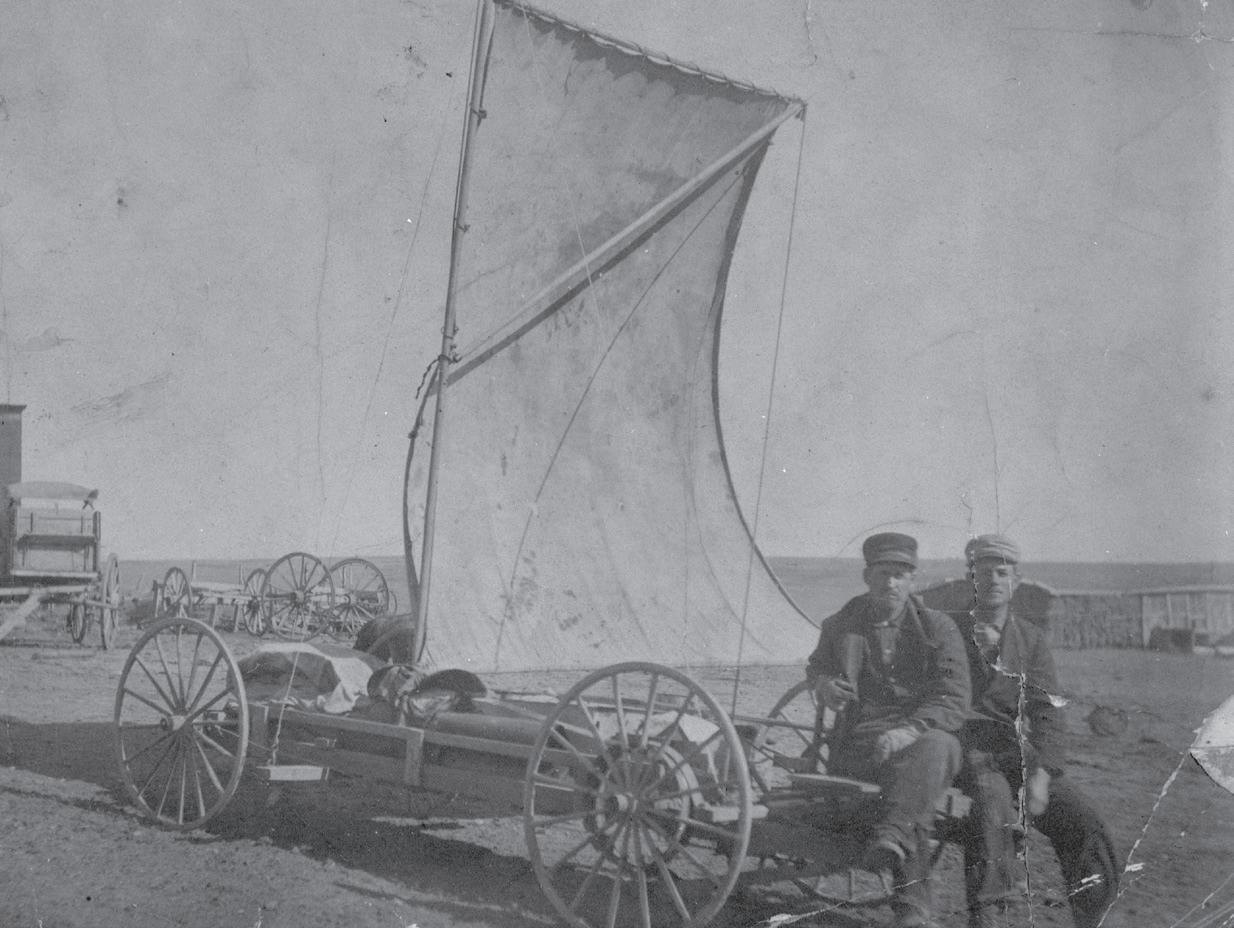
The air is so clear, the breeze so pure, The zephyrs so balmy and light, I would not exchange my home here to range Forever in azure so bright.
Kansas newspapers found the irony in “promiscuous” zephyrs when gentle breezes became threatening tornadoes. Bowersock Mills in Lawrence produced a popular Zephyr flour. Chicago, Burlington, & Quincy Railroad’s sleek 1934 diesel-powered train, Zephyr, offered service to Kansas City. We remember the wind with our new bimonthly publication, Zephyr, featuring the latest happenings of the Kansas Historical Society.
What’s coming next on the Kansas wind?
September/October 2023 2 Zephyr Contents
From the Executive Director 2023 Kansas Archeology Training Program Kansas Preservation Summit and Conference New National and State Register Listings On the Move: A Special Exhibit Preserving the Past - Preparing for Storage Adding to the Story of Abbie Bright Taking Inventory: Audio/Visual Collections Presenting: Kaw Mission and Last Chance Store Autumn Travel in Kansas History On this Day in Kansas History News and Notes Calendar 3 4 7 8 10 12 14 16 17 18 20 22 23 September/October 2023 - Issue 1, Volume 1 Patrick Zollner, Executive Director, State Historic Preservation Officer Bobbie Athon, Editor in Chief Ashley Wunder, Managing Editor Kim Korber, Layout Designer Anne Dorcey, Graphic Design Consultation Brenda Kipp, Contributing Writer Published by the Kansas Histoical Society 6425 SW 6th Avenue Topeka KS 66615-1099 Please send change of address information to the above address or email kshs.information@ks.gov. Partial funding provided by the National Park Service, Department of the Interior. The contents and opinions do not necessarily reflect the views or policies of the Department of the Interior, nor does the mention of trade names or commercial products constitute an endorsement or recommendation by the Department of the Interior. This program receives federal funds from the National Park Service. Regulations of the U.S. Department of the Interior strictly prohibit unlawful discrimination in departmental federally assisted programs on the basis of race, color, national origin, age, or handicap. Any person who believes he or she
From the Executive Director
Patrick Zollner
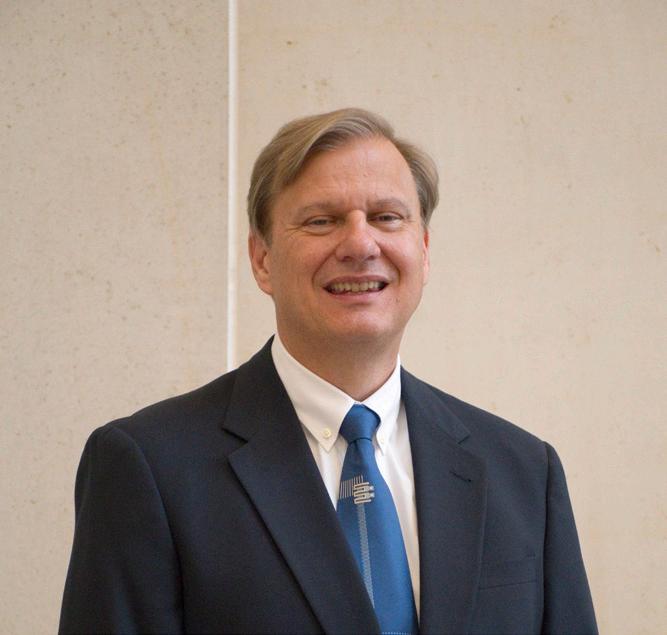
Welcometo Zephyr, the Kansas Historical Society’s new bimonthly publication! People often ask me what we do at the Historical Society, especially since the Kansas Museum of History is undergoing major renovation. Our work continues in collecting, preserving, and interpreting Kansas history. The museum project is moving forward behind-the-scenes and with involvement from all divisions. Meanwhile, our agency’s work continues with our many other programs. We are providing this newsletter free of charge to help Kansans understand and access these programs more easily.
This newsletter follows other similar Historical Society publications. Our predecessors knew the importance of imparting information about active programs. The agency’s publications began as the Collections in 1875, followed by Transactions, and Quarterly, all containing Kansas history and updates on the Society.
The Society added a newsletter, the Mirror, which launched in January 1955. The publication was inspired by Angelo C. Scott, publisher of the Iola Register and 19541955 president of the Society, to raise awareness. Secretary Nyle Miller accepted the proposal, promising not to “bore prospective readers.” The Mirror offered insights into the Society’s active projects, sites, employees,
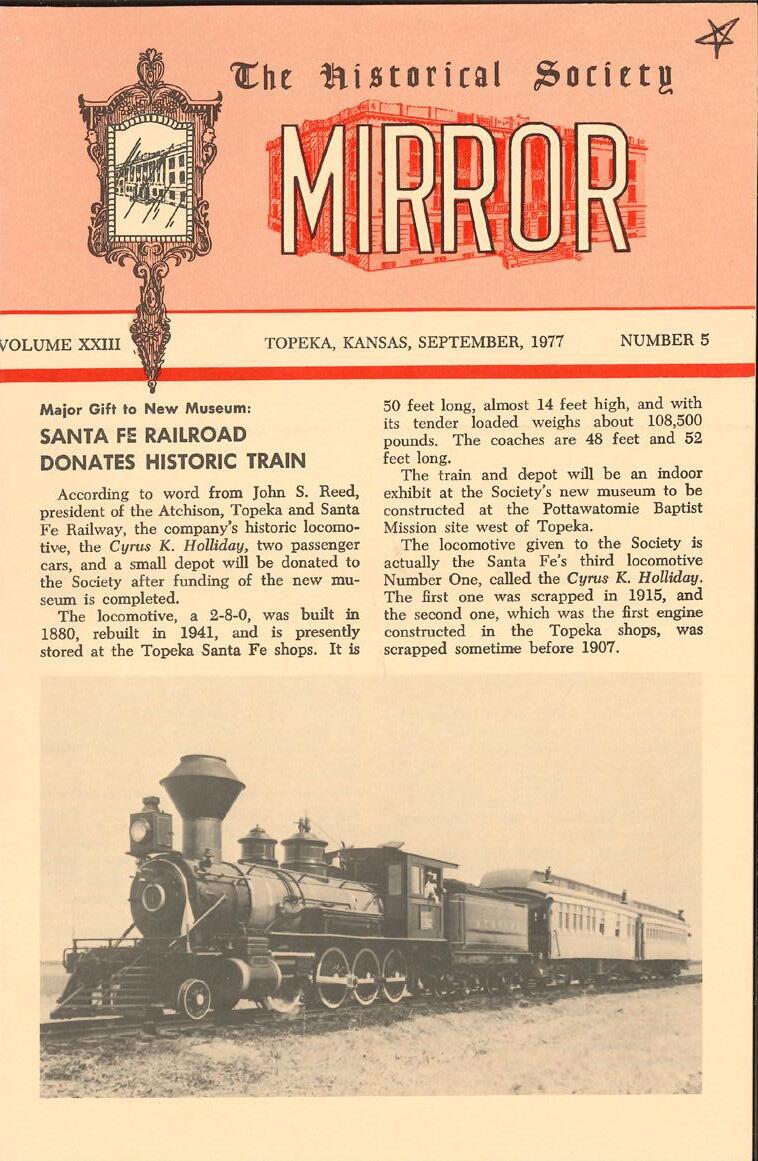
board members, and volunteers. Miller used the publication with great success, appealing to readers to fill the period rooms with donated items. He celebrated appropriations for needed improvements to the Memorial building in 1961, and reported only “modest” damage to the building after the 1966 Topeka tornado. Executive Director Ramon Powers notified readers that the Mirror would be replaced by a new publication, Kansas Heritage, in 1993. That quarterly magazine ended in 2006 and was replaced by another, Reflections, which ceased in 2017.
The Kansas Historical Quarterly was published for 46 years. It was replaced by Kansas History: A Journal of the Central Plains, an academic peer-reviewed publication, redesigned for larger illustrations, which launched in Spring 1978. The publication continues today with the latest scholarship in Kansas history.
We are excited about the opportunity to connect you to our many programs with this new newsletter. We look forward to your comments and appreciate your interest and support.
Comments?
Thank you for engaging with Zephyr! We value your support and are grateful for your input. To leave feedback on this issue or provide suggestions for future issues, scan this QR code. ->

Kansas Historical Society Zephyr 3
Patrick Zollner was appointed executive director in March 2023.
ARCHEOLOGY
Protecting and understanding the archeological resources of Kansas— working with local, state, and tribal entities, offering educational programming, and conducting and sharing research.
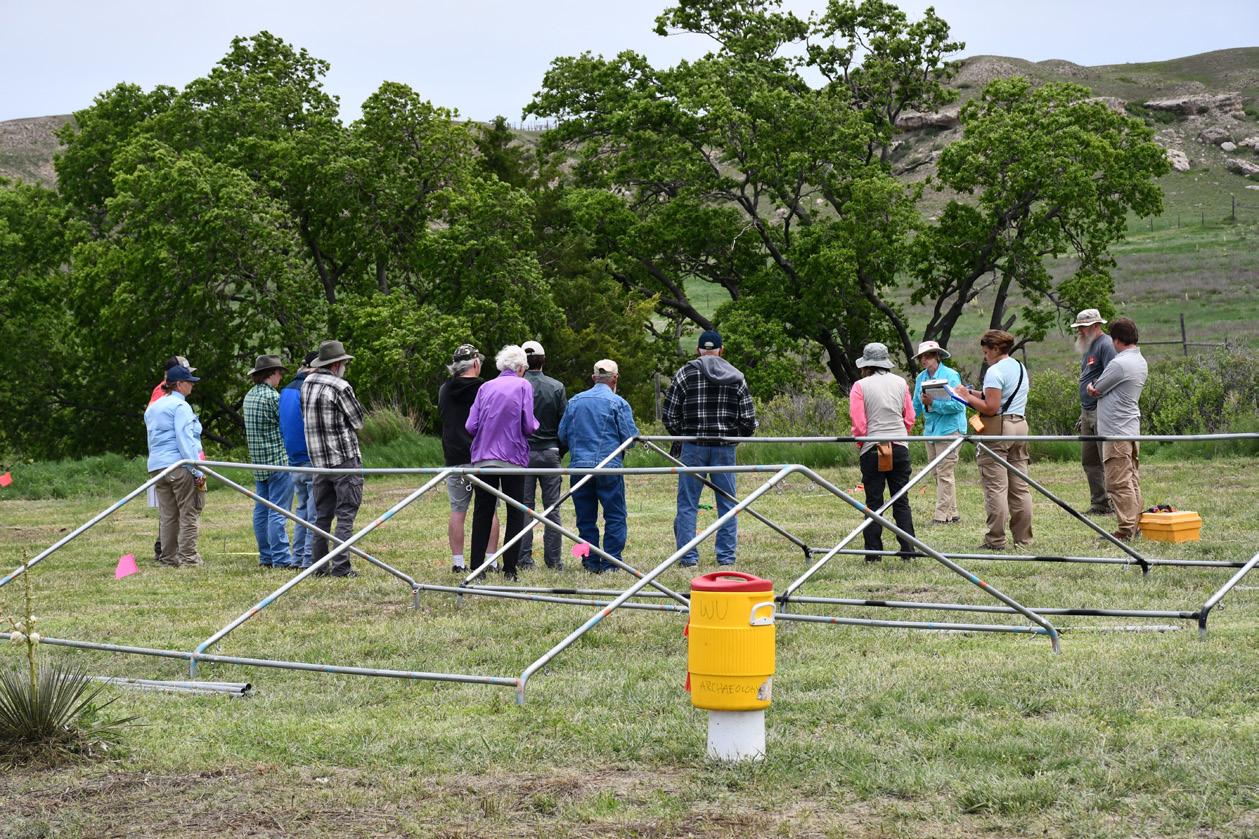
2023 Kansas Archeology Training Program in Scott County
By Shelby Beltz, MA, Public Archeologist
Thispast June archeologists from the Kansas Historical Society (KSHS) partnered with the Kansas Anthropological Association (KAA) as well as archeologists from the University of Iowa and University of Oklahoma for the 2023 Kansas Archeology Training Program (KATP). The KAA has a longstanding partnership with the KSHS. Established on the Fort Hays State University Campus in 1955, the main goal of the KAA was to survey the state of Kansas and record archeological sites.
The organization started hosting weekend events with assistance from Tom Witty, the state archeologist at the KSHS from 1960 to 1994, to survey and excavate sites. Witty and KAA members came together in 1974 to establish a training program that would involve the public in the excavation of archeological sites across the state. The first KATP was held in 1975 at the El Quartelejo site in Scott County.
For the 46th annual KATP, the archeology team returned to Scott County from June 2 to June 18 for the first time in 14 years to help excavate a Dismal River aspect site dating from AD 1680 to 1780. The people that once lived at Dismal River aspect sites are the ancestors of the modern-day Apache Tribe
of Oklahoma. The site was first recorded by archeologists in 1976 and re-identified in 2009 for a KATP survey field school. Dr. Matthew E. Hill, from the University of Iowa, and Dr. Sarah Trabert, from the University of Oklahoma, are interested in the site and have conducted several small scale field schools there since 2013. This year KSHS partnered with Drs. Hill and Trabert to further their knowledge and understanding of the site. The main goal of this field school was to gather information that could contribute to the listing of the site in the National Register of Historic Places. To do this the site needed intact features that would help in furthering our understanding of the Dismal River aspect people.
Volunteers from across the nation came to participate in this year’s field school. A total of 127 participants dedicated 4,578 hours to excavating the site as well as working in
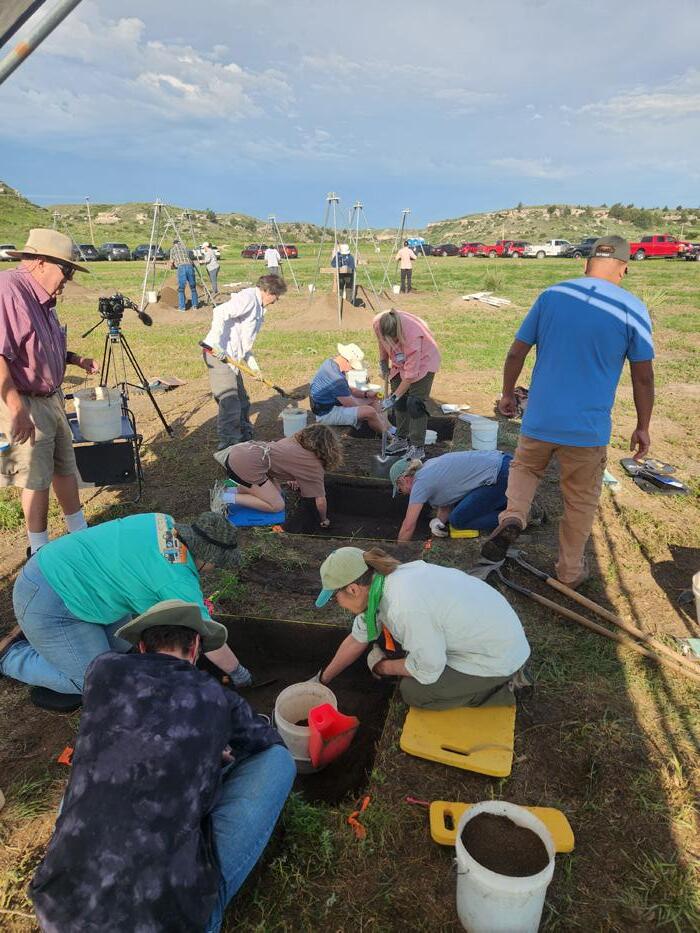
September/October 2023 4 Zephyr
the lab washing, sorting, and cataloging the artifacts that were recovered. The excavations recovered limited artifacts but were rich in features, including eight possible post molds and two possible pits.
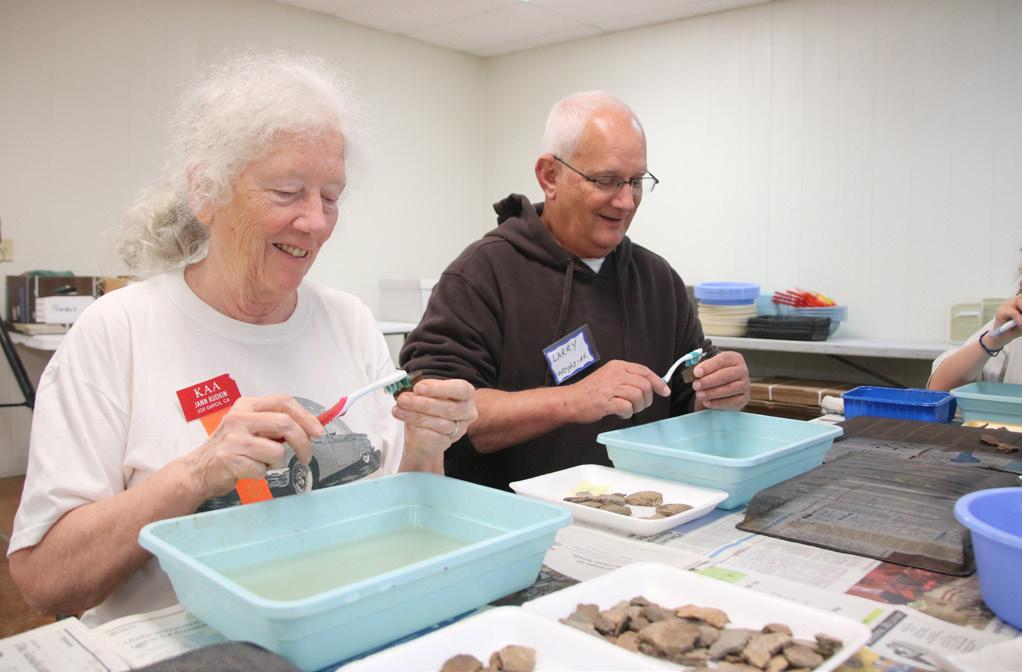
Post molds are indicative of a structure and when measured, the diameter of the structure was approximately five meters. Dismal River aspect houses were typically constructed in a wickiup style measuring between three to five meters in diameter. The two possible pits were identified as a slightly darker soil stain and were lacking in artifacts. One of the pits did contain some burned rock, small seeds, and flecks of charcoal. Of the stone artifacts found, most appeared to be more of an expedient tool than one crafted for a specific purpose. A single projectile point was identified on the surface outside of the excavation areas, but likely predates the occupation here.
The features and artifacts uncovered help us understand what function the site would have served for its inhabitants. The low density of artifacts may indicate the site was utilized as a seasonal campsite as opposed to a habitation site. The larger number of expedient tools
recovered in 2009 and 2023 and the limited stone or lithic debris also indicate there was little stone production occurring at the site. As excavations continue across the site, it is possible for these interpretations to change with more information.
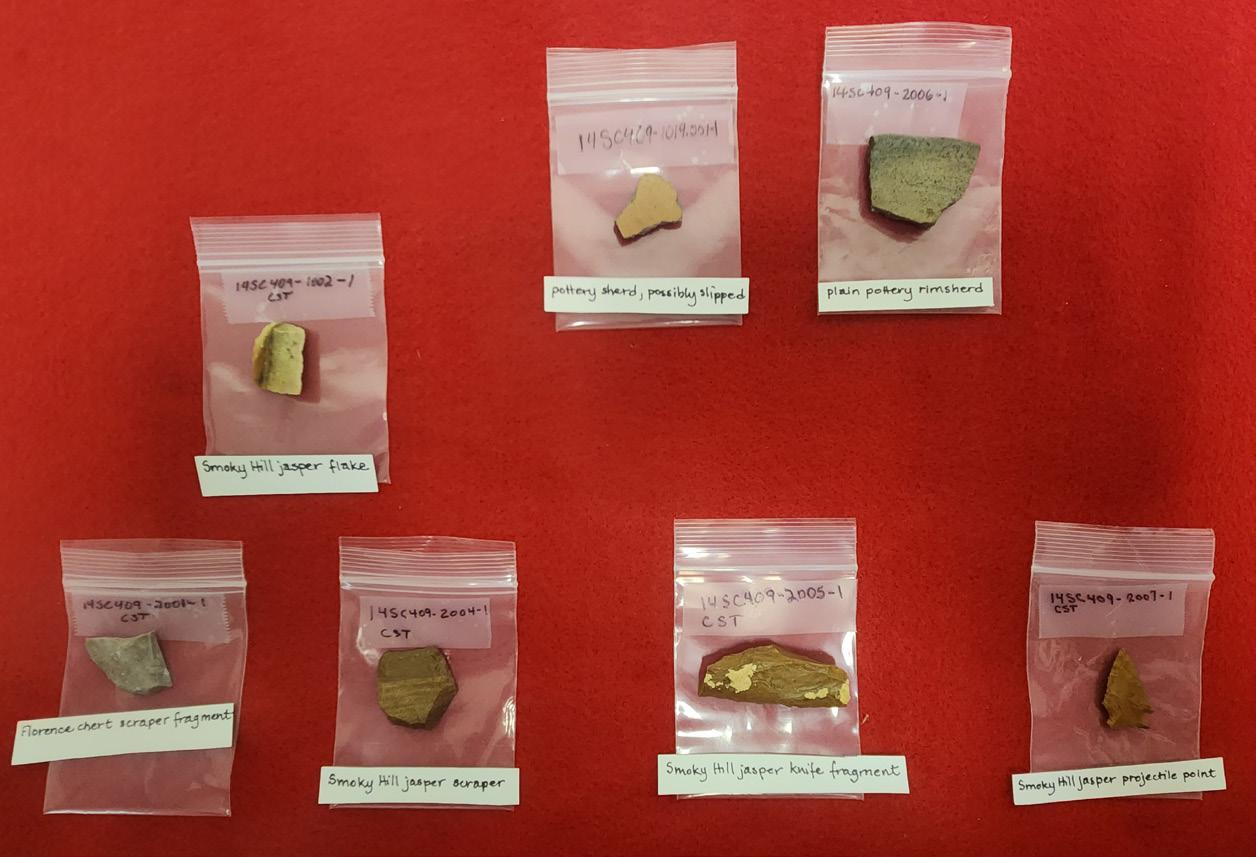
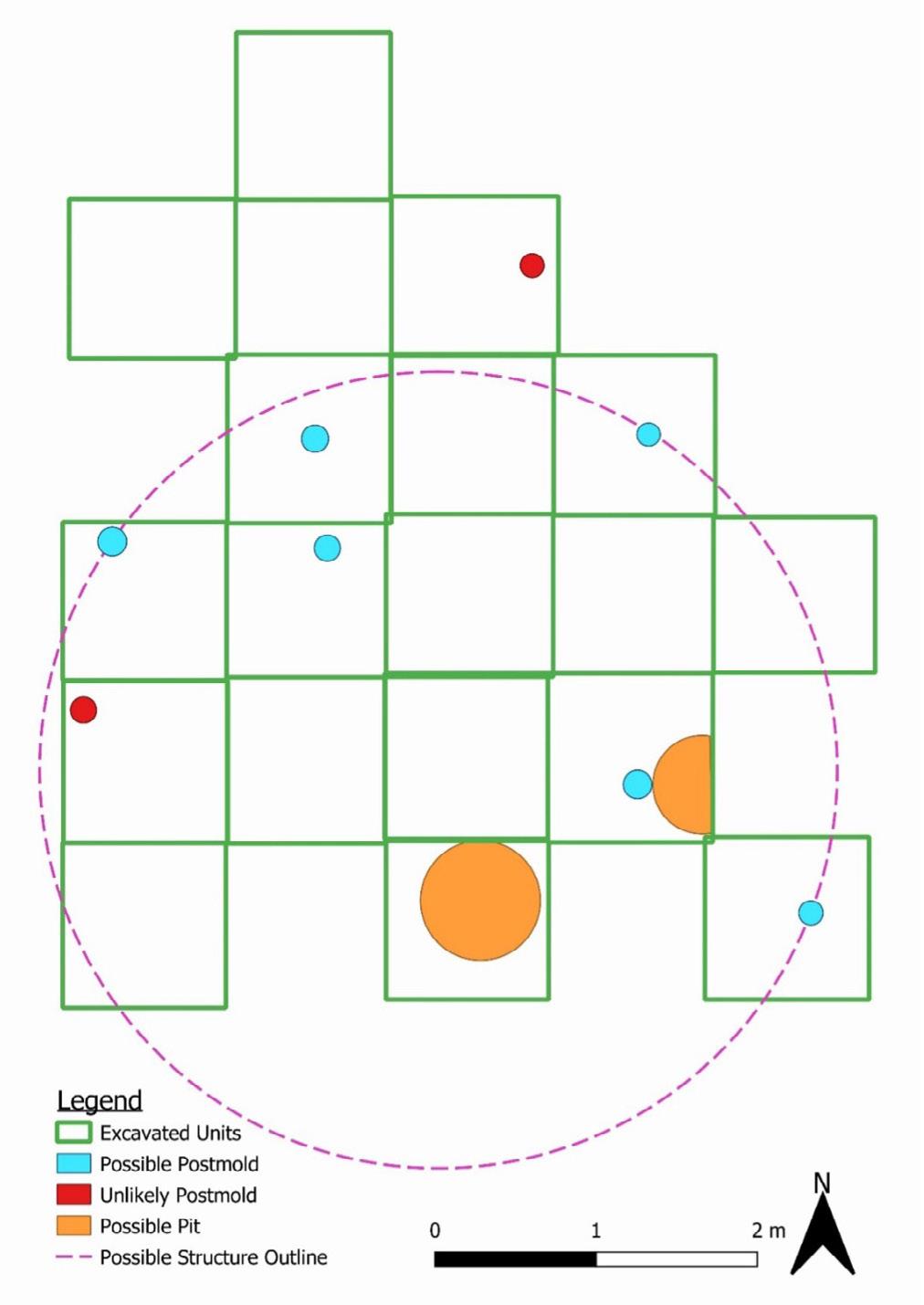
The field school attracts many visitors from the surrounding communities with a total of 59 individuals visiting the site and the lab.
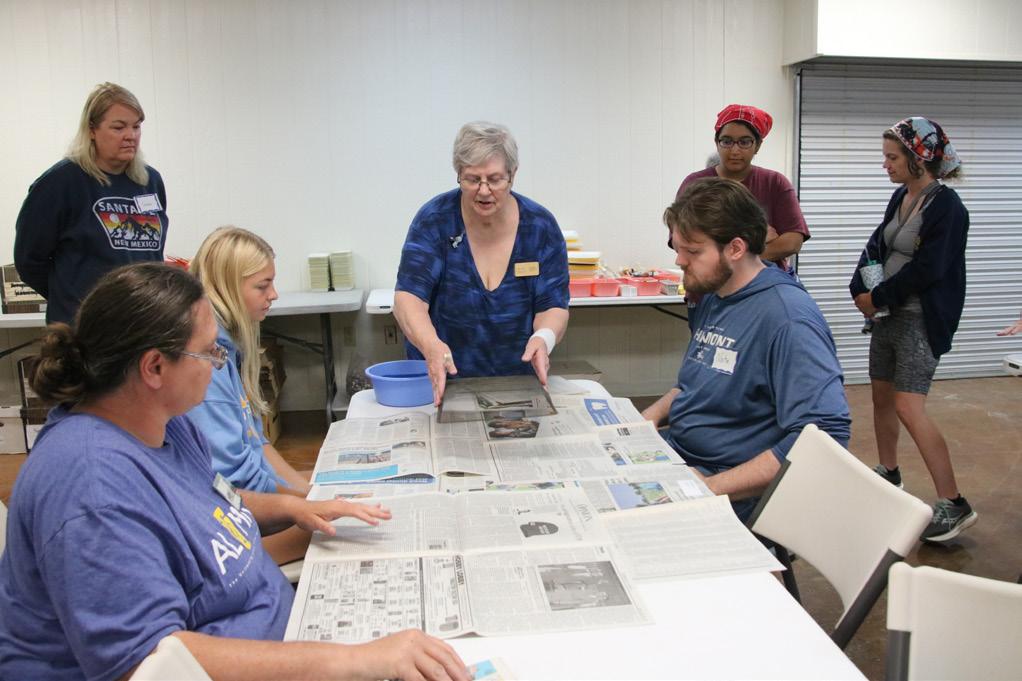
Kansas Historical Society Zephyr 5
We are always happy to welcome the local community and share what we are doing. This year we were especially honored to welcome Nadine Cheney, a founding member of the KAA and volunteer at the first KATP, who joined us in the field and lab.
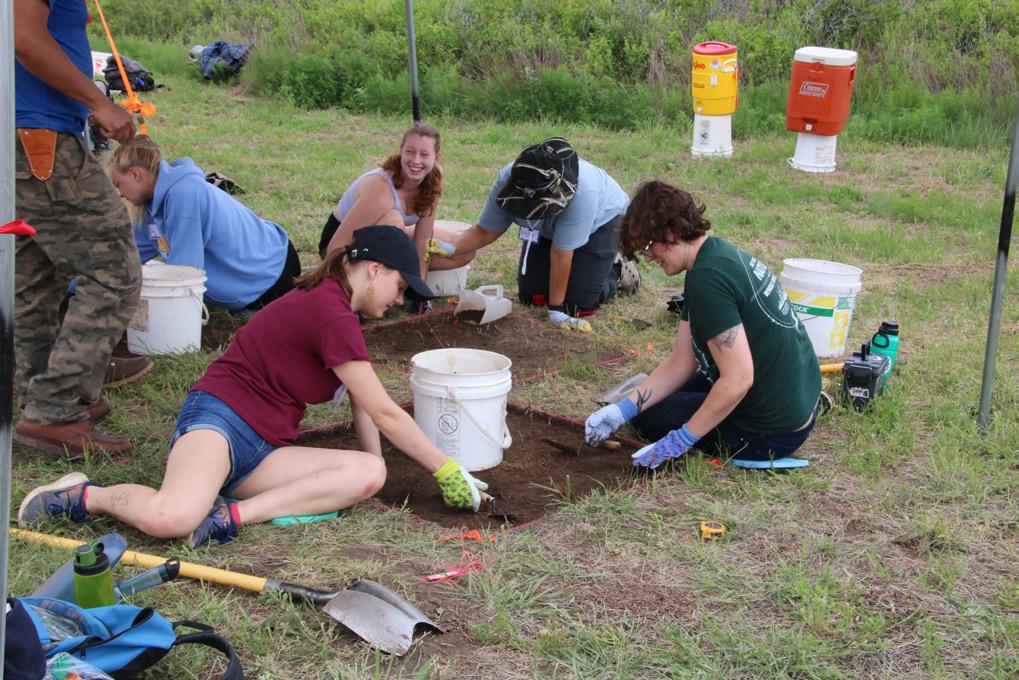
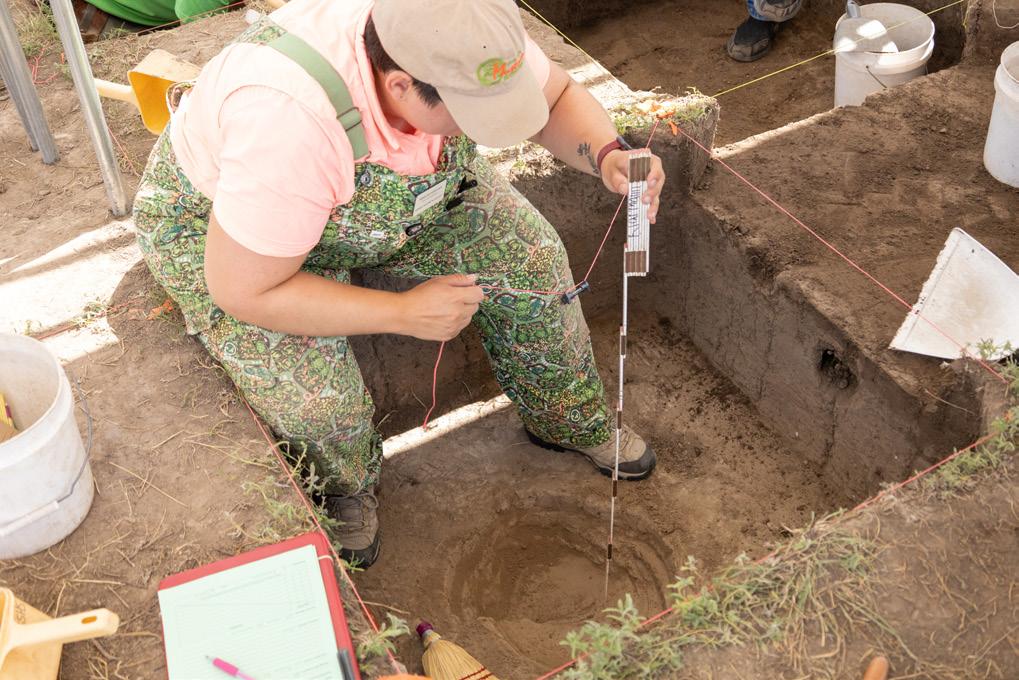
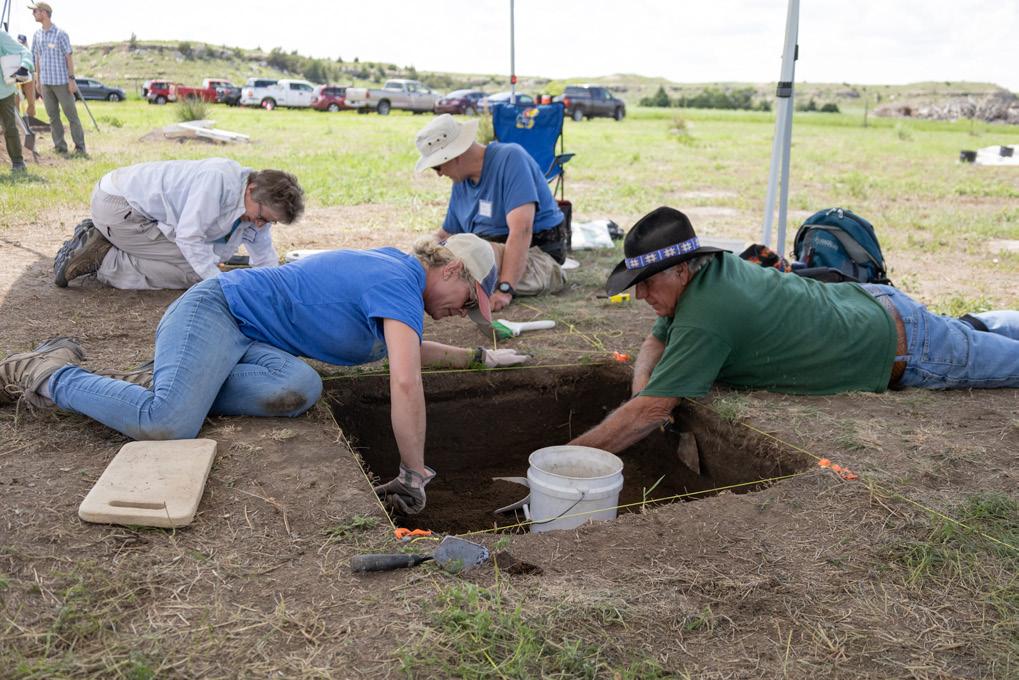
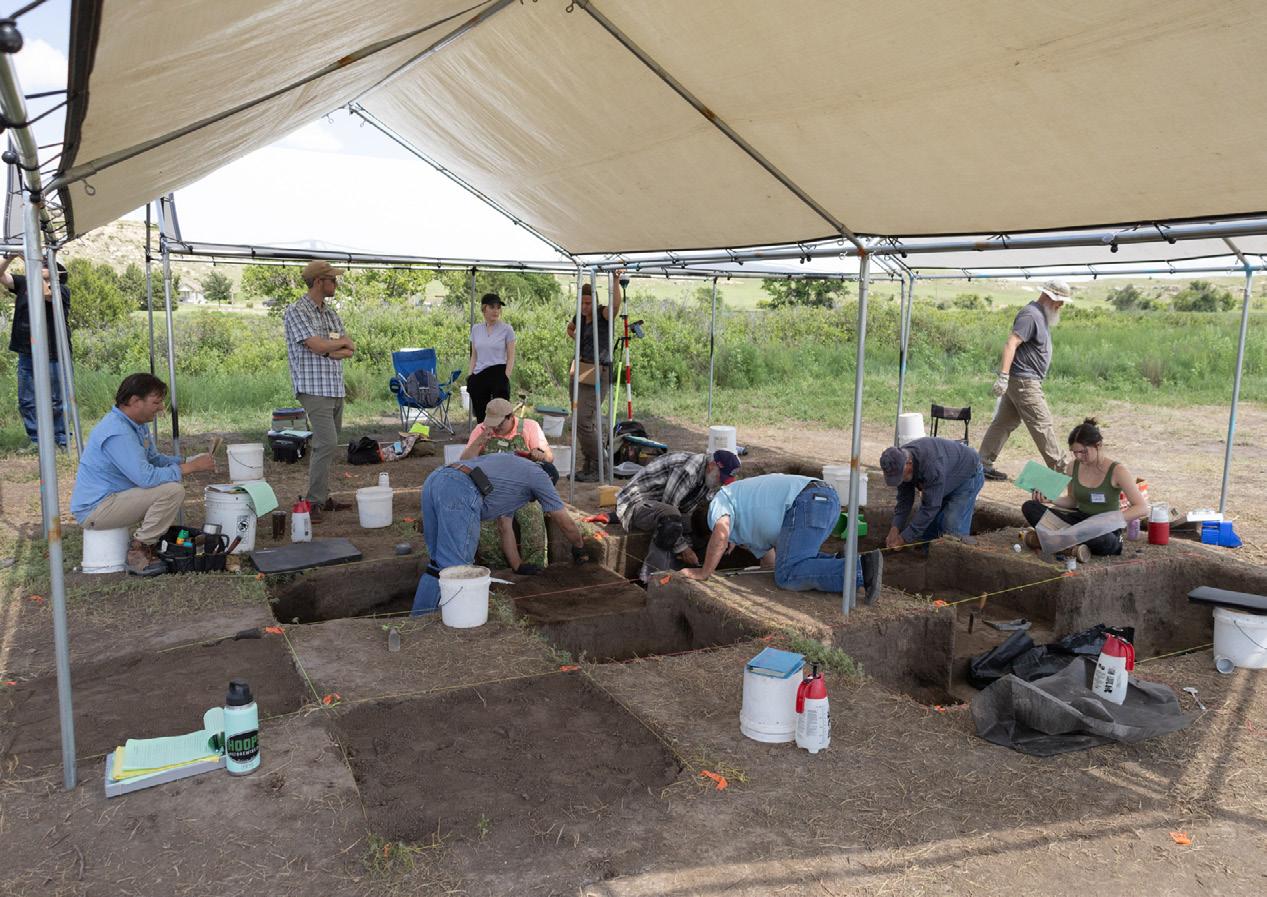
While excavations and lab work are ongoing, KATP also offers special-topic classes that volunteers can participate in that give them additional hands-on experiences with different aspects of archeology. This year we offered a laboratory techniques class and an archeological survey class. The lab class participants learned how to properly sort, catalogue, and reconstruct artifacts. The survey class was taught by an out of agency professional, Wesley Gibson, where pedestrian survey was conducted throughout different areas of Historic Lake Scott State Park, focusing on locations with already documented archeological sites. This class was able to re-identify two recorded sites and record a new one. A workshop was also offered, Project Archaeology, part of a national curriculum in archeology, which spurred great discussions about shelter and migration within Kansas.

For more information about the Kansas Archeology Training Program, scan this QR code. ->

September/October 2023 6 Zephyr
STATE HISTORIC PRESERVATION OFFICE (SHPO)

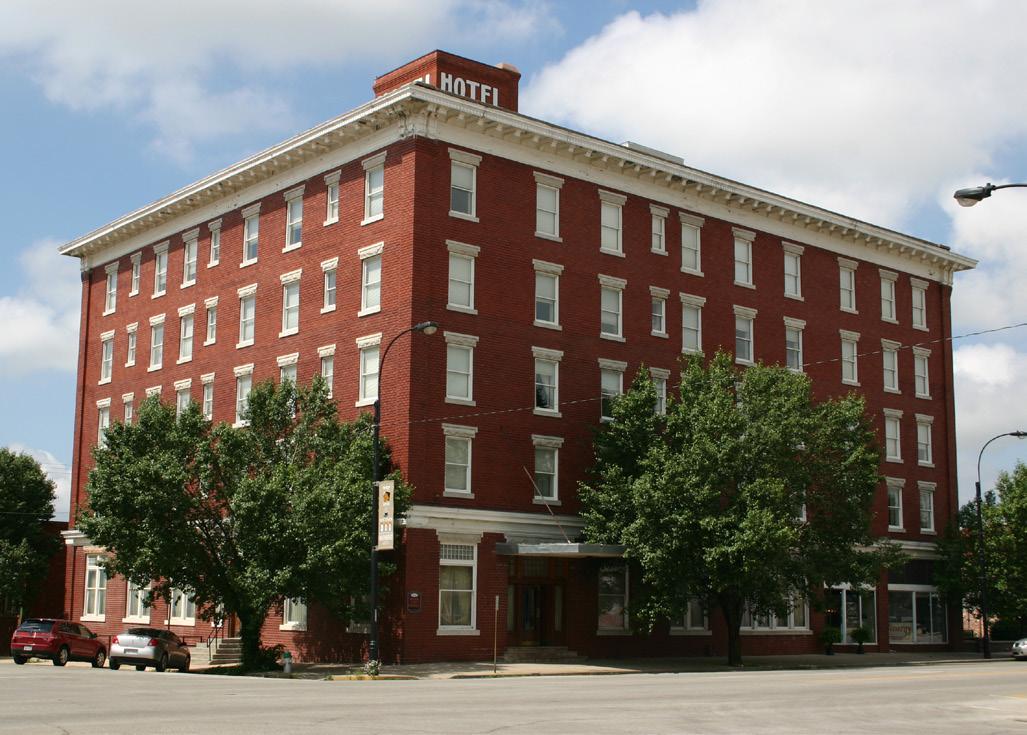
Preserving and protecting the state’s historic buildings, structures, and sites through financial assistance programs, technical guidance, and regulations; working with federal, state, and local communities and partners to interpret and preserve these resources.
SHPO SUMMIT AND CONFERENCE
Kansasmarked Preservation Month in May with several activities. Members of the Illinois, Idaho, Iowa, Kansas, Minnesota, Missouri, Nebraska, Ohio, Oklahoma, Texas, and Indiana historic preservation offices and the National Park Service gathered in Topeka on May 1-2, 2023. They met at the Kansas State Capitol to discuss common problems and potential solutions within historic preservation. The group also toured two historic rehabilitation projects in downtown Topeka. With the meeting’s success, participants set a similar gathering in Iowa in two years.
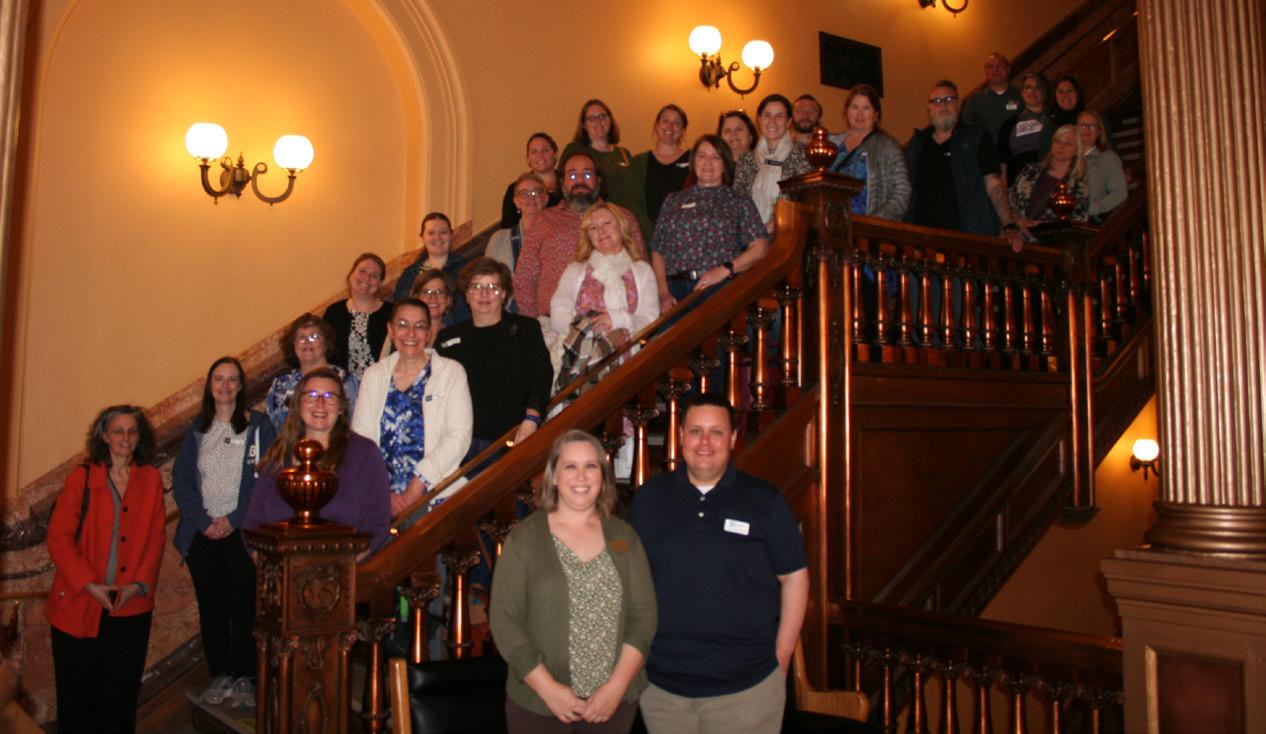
The 2023 Kansas Preservation Conference followed in Independence May 4-6. Participants gained insights into preservation, explored local architecture, and learned about preservation challenges and successes. Tracks focused on technical and professional preservation resources and Main Street programs and included networking and tours. Lisa Mullins Thompson, keynote speaker, serves as senior program office for revitalization services at Main Street America. Caitlin Meives, luncheon speaker, is director of preservation at The Landmark Society of Western New York and a former survey coordinator at the Kansas Historical
Society. Staff members from the National Park Service tax credit program were also featured speakers.
This annual conference was held in conjunction with Kansas Main Street. Staff members from the State Historic Preservation Office (SHPO) worked closely with the Kansas Main Street office and the Independence Main Street office, City of Independence, and Independence Chamber of Commerce to organize the first in-person preservation conference for Kansas since 2019. The 2024 Kansas Preservation Conference will be held in Newton at a date to be announced. Request notifications for upcoming conferences and events at kshs.shpo@ks.gov; 785-272-8681, ext. 240.
Kansas Historical Society Zephyr 7
Booth Hotel • Independence Memorial Hall • Independence
Representatives from 11 historic preservation offices and the National Park Service gather on the steps in the Kansas State Capitol.
New National and State Register Listings
TheNational Register of Historic Places is the nation’s official list of historically significant properties. The State Historic Preservation Office (SHPO) at the Kansas Historical Society administers this and the Register of Historic Kansas Places. The state’s Historic Sites Board of Review meets every quarter with SHPO staff members and determines which properties to nominate to the National Register.
These Kansas properties were recently evaluated by the Office of the Keeper in Washington, D.C. and approved to be listed.
The two-story Italianate brick Henry Waters House was built in 1872. The house was designed to include a cellar that housed Waters’ processing and distribution operation for patent medicines. Waters and partners, C. Wakefield & Company, were members of the Proprietary Association of America, a patent medicine manufacturing organization.
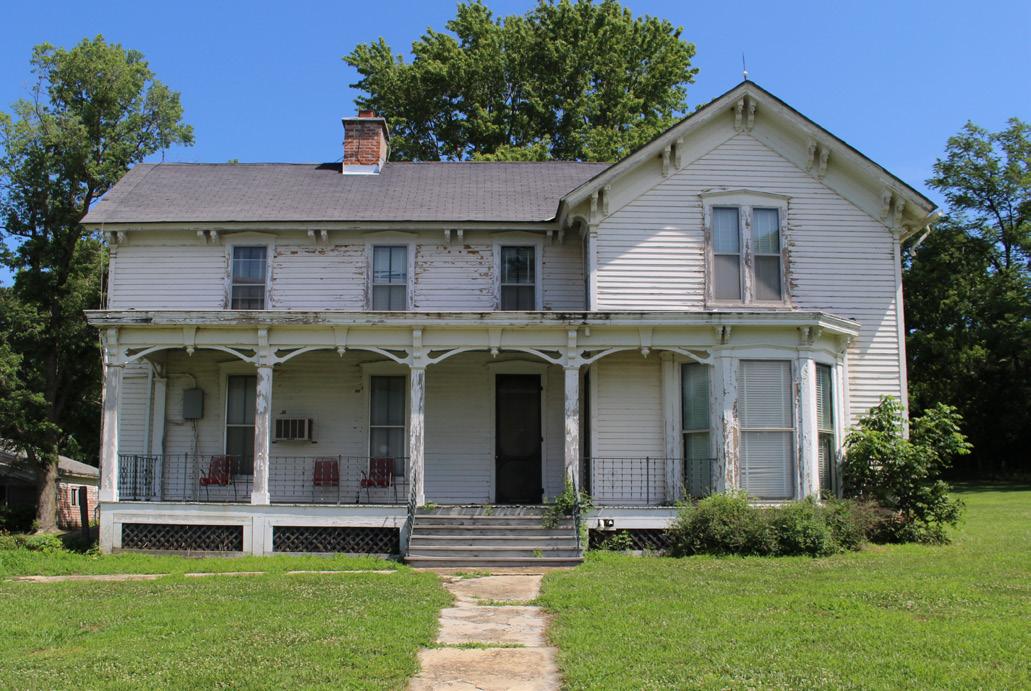
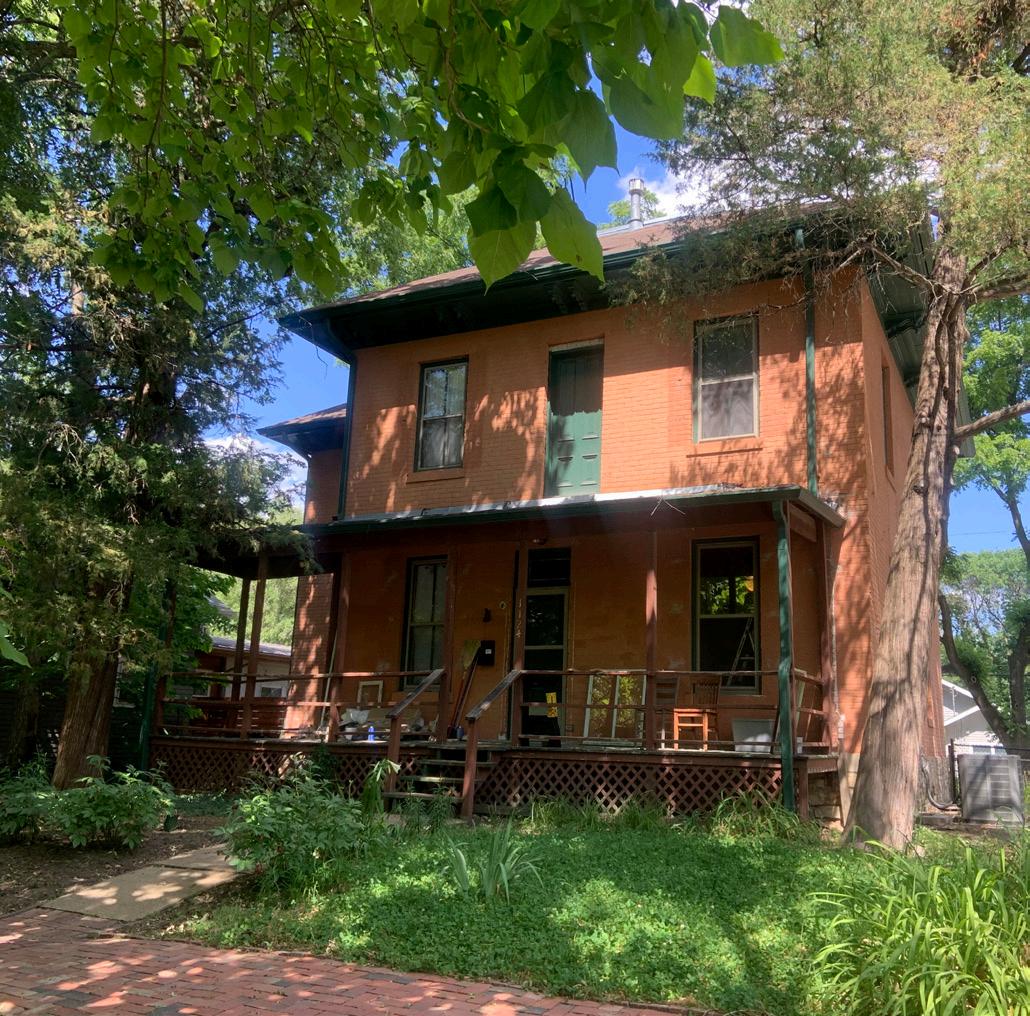
Located on a sloping hillside above the Marais de Cygnes River and floodplain, the Luther Severy & Son Stock Farm played an important role in agriculture during the area’s settlement period. The 3,000-acre stock farm is an outstanding example of agricultural commerce and retains excellent integrity. The stock farm buildings and landscape have endured for 140 years.
Many of Topeka’s African Americans used this cemetery for burials from about 1885 until 1941. These individuals represent leading members of the Black community, members of the Exoduster movement, local businessmen, inventors, teachers, and veterans. The cemetery is named for abolitionist John Ritchie, one of Topeka’s founding fathers, who originally owned much of the property near downtown Topeka.
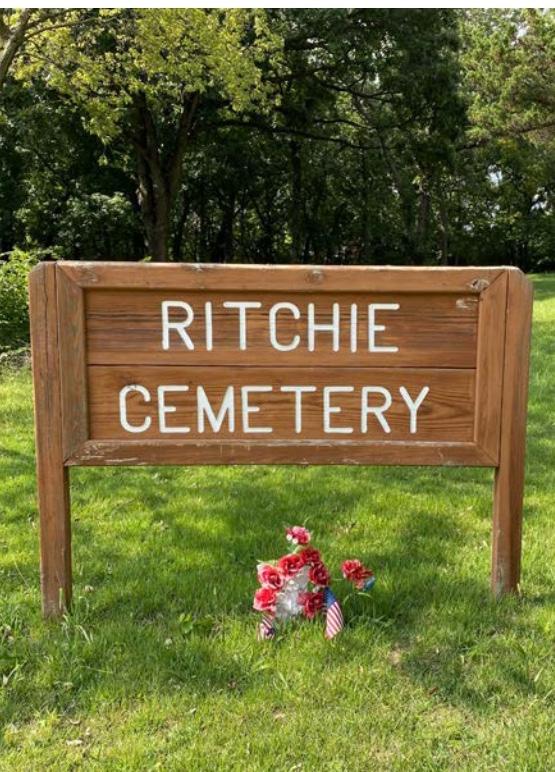
September/October 2023 8 Zephyr
Henry Waters House • Lawrence (Douglas County)
Luther Severy & Son Stock Farm • Reading (Osage County)
Ritchie Cemetery • Topeka (Shawnee County)
Henry Waters House • Lawrence
Luther Severy & Son Stock Farm • Reading
Ritchie Cemetery • Topeka
Pioneer Hall, Kansas Wesleyan University • Salina (Saline County)
This distinguished four-story Collegiate Gothic building is located on the Kansas Wesleyan University campus. The hall had an important role in educating the surrounding community. The hall was designed by Wichita architect Lorentz Schmidt and Company and constructed between 1922-1930.
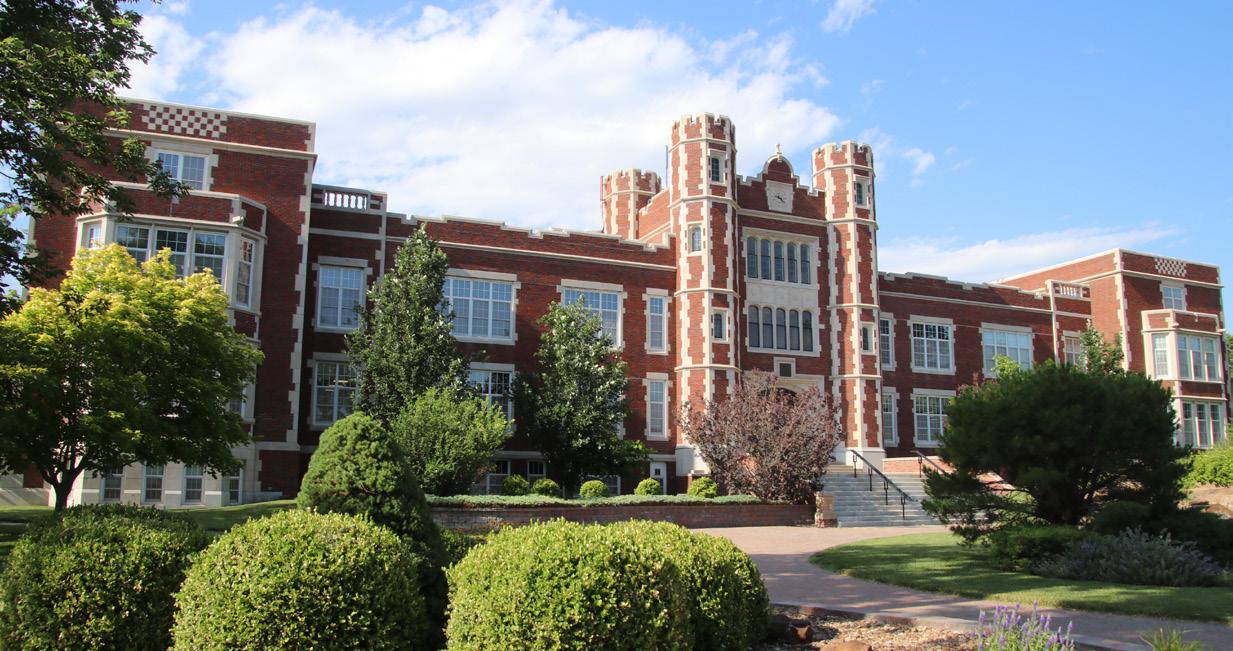
Whittier School • Kansas City (Wyandotte County)
This three-story school building with brick walls was built between 1919 and 1922. It has a quarry-faced stone foundation and concrete structural system. This was the first school in Kansas City to include a separate kindergarten facility. It is an excellent example of the Progressive Era school design and is also important for its association with education.


Yuma Street Historic District • Manhattan (Riley County)
This south Manhattan district includes the Second Baptist Church, United Service Organization, Douglass Park, Douglass School, and Shepard Chapel. The African American population was expanding in Manhattan in the early 1900s, but since has decreased. The oldest building in this district is 1904; more recent buildings date from the Civil Rights Era in 1968.
National Register Nominations
The Historic Sites Board of Review nominated these eight properties on Saturday, May 6, 2023.
Abraham Brien House
Reserve, Brown County
Amerine Hill Crest Farm (Morris Harris)
Williamstown (Perry), Jefferson County
Vinland Fair Association Fairgrounds
Baldwin City (vicinity), Douglas County
Barnes/Hoskinson Farmstead
Vinland (vicinity) Douglas County
Anna Richardson-Brown House
Nickerson, Reno County
Peters Science Hall, Kansas Wesleyan University
Salina, Saline County
C.L. Henderson House
Wichita, Sedgwick County
Hazen L. Kirkpatrick House
Topeka, Shawnee County
For more information about the National Register of Historic Places and Register of Historic Kansas Places, scan this QR code. ->
Whittier School • Kansas City

Kansas Historical Society Zephyr 9
Pioneer Hall, Kansas Wesleyan University • Salina
Yuma Street Historic District • Manhattan
MUSEUM AND EDUCATION
Using stories from Kansas history to encourage new explorations of the past, understand our present, and appreciate the experiences of others; collecting, preserving, and providing access to the state’s material culture.
Presenting On the Move: A Special Exhibit
Nowshowing at the Kansas Historical Society, this temporary exhibit highlights the process of moving collections from the Kansas State Capitol to the Kansas Museum of History. After filling our space in the Capitol, the Historical Society moved across the street to Memorial Hall. The museum collections were moved to west Topeka, creating the Kansas Museum of History in 1984.
Nearly 40 years later, the Museum closed for major renovations with an opening scheduled for 2024. Look back at the fascinating history of the Kansas Museum of History and glimpse exciting new floor plans to come.
For current hours and more information about the special exhibit scan this QR code. ->

ABOVE:
Window clings (left) entice visitors to discover more pictures, artifacts, and stories about the museum’s various moves.
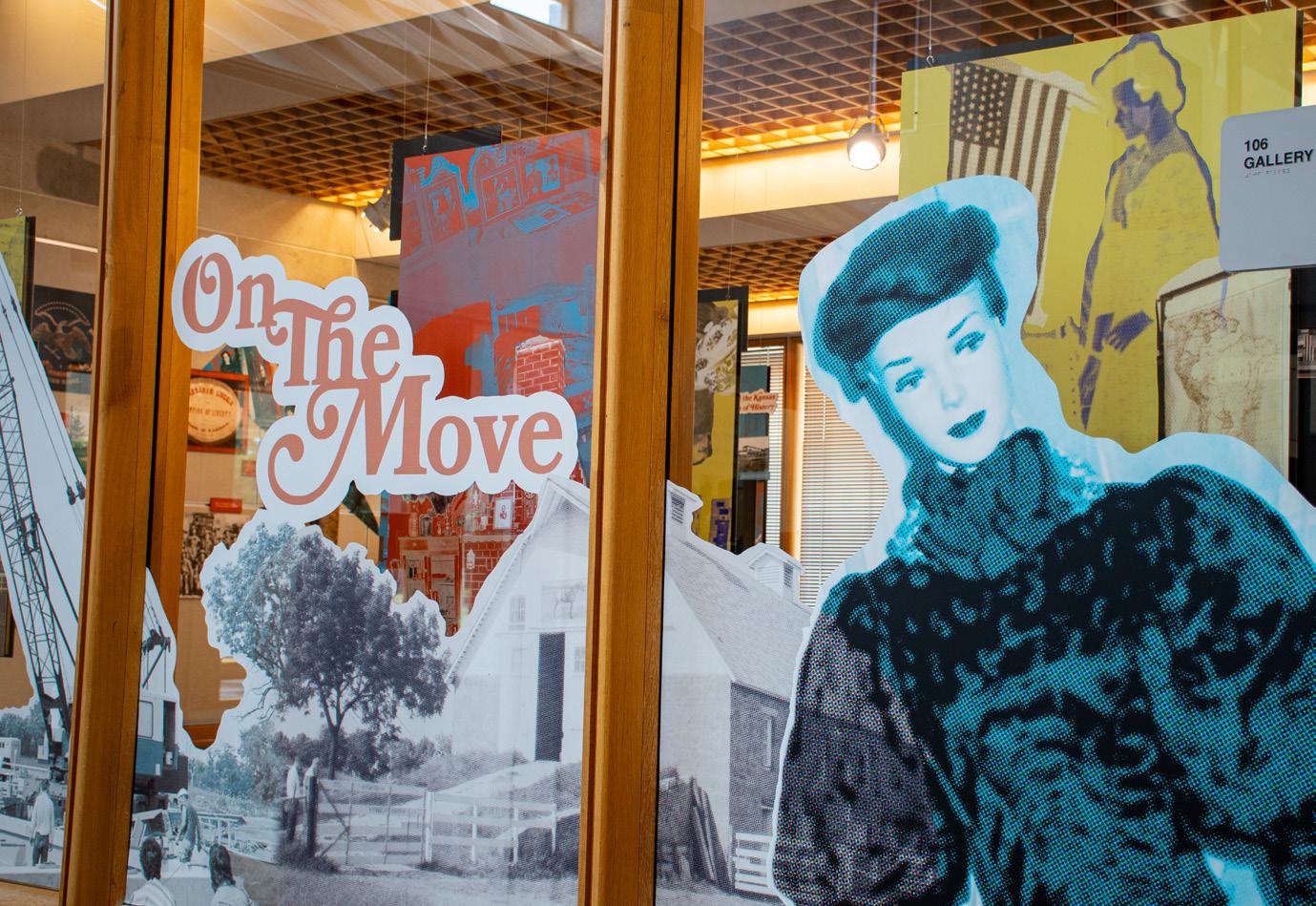
Museum staff members (right) roll “Fox”, a papier-mâché horse, into place in the special exhibits gallery.
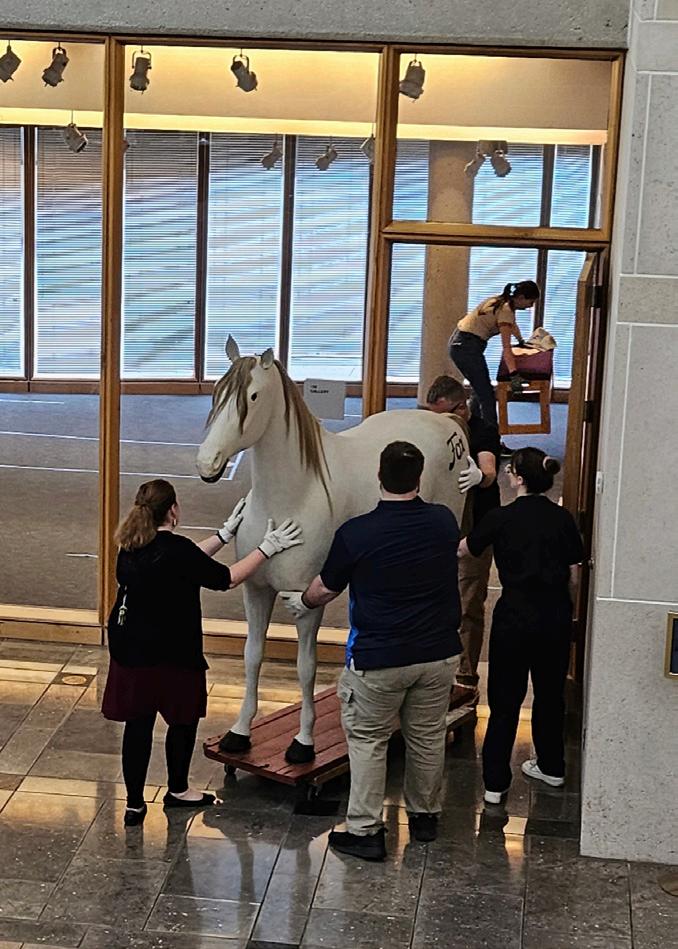
SPECIAL EXHIBIT HOURS
9 a.m. – 4:30 p.m. Monday – Friday
9 a.m. – 12 p.m. the last Saturday of the month
*Hours subject to change
Kansas Historical Society
Special Exhibit Gallery
6425 SW 6th Avenue · Topeka
September/October 2023 10 Zephyr
Staff Member Highlight
Dorcey, Exhibits Designer
By Brenda Kipp, Content Creator
Anne Dorcey is the exhibits designer for the Kansas Museum of History. Anne creates exhibit layout designs and assists with exhibit construction. She also uses her graphic design skills for additional projects.

A native of Emporia, Anne has a bachelor’s degree in graphic design and history from Pittsburg State University. She’s currently working on her master’s degree in history at Pittsburg State. Anne developed a love for Kansas history as a teenager and worked as a capitol tour guide at the Kansas State Capitol before joining the museum staff.
She views her current position as her dream job and enjoys being a part of keeping Kansas history alive. A sixth generation Kansan, Anne can trace her Kansas roots back to the 1870s.

Anne’s latest project is the On the Move temporary exhibit. Her exhibit design was inspired by 1980s graphic styles. The goal was to create a design based on techniques, like screen printing, that were commonly used in the 1980s when the museum moved from downtown to its current location.
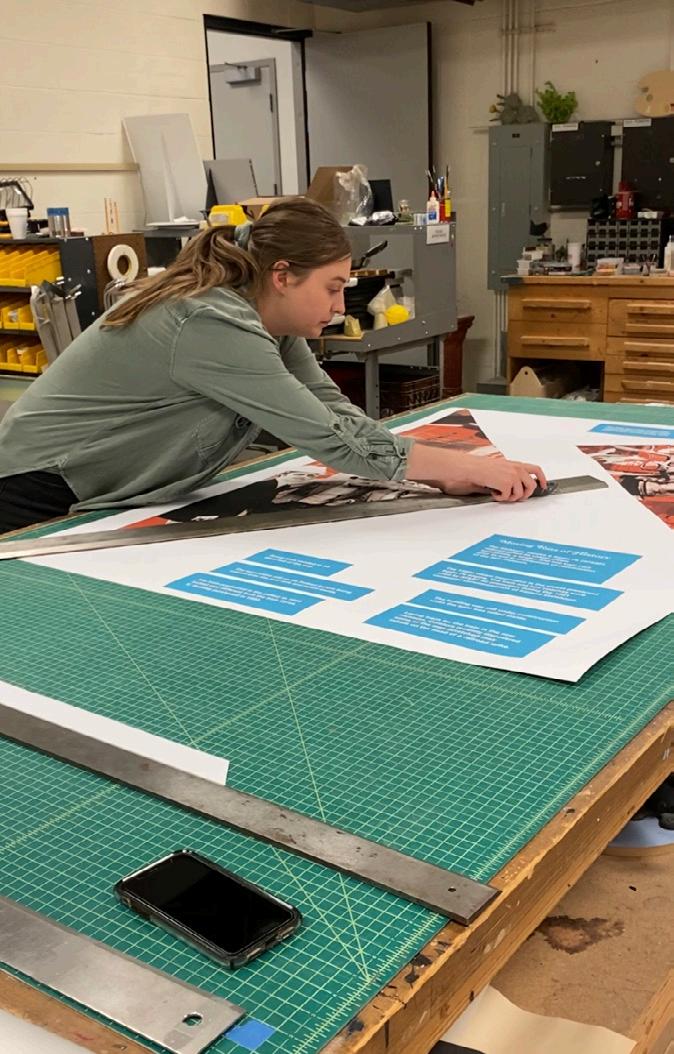
Anne is excited about the changes that are coming to the museum’s main gallery and is looking forward to being involved in the new gallery design.
Watch for Virtual Museum After Hours live at 6:30 p.m. on the second Wednesday of each month. The programs are free! Register on Zoom using the program links or follow the series on the Kansas Historical Society YouTube channel where past programs can also be viewed.
Virtual Museum
After Hours!
Kansas Historical Society Zephyr 11
Anne
PRESERVING THE PAST
The Kansas Museum of History’s major renovations for new exhibits are well underway, made possible by the Kansas Historical Foundation’s capital campaign. One step in this process has been to carefully remove 2,000 artifacts on display and prepare them for museum storage.
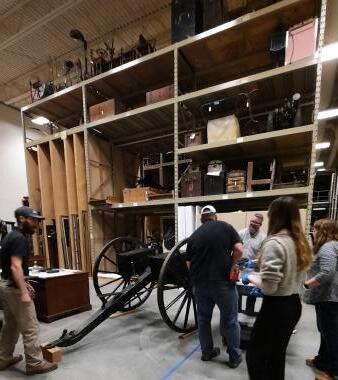
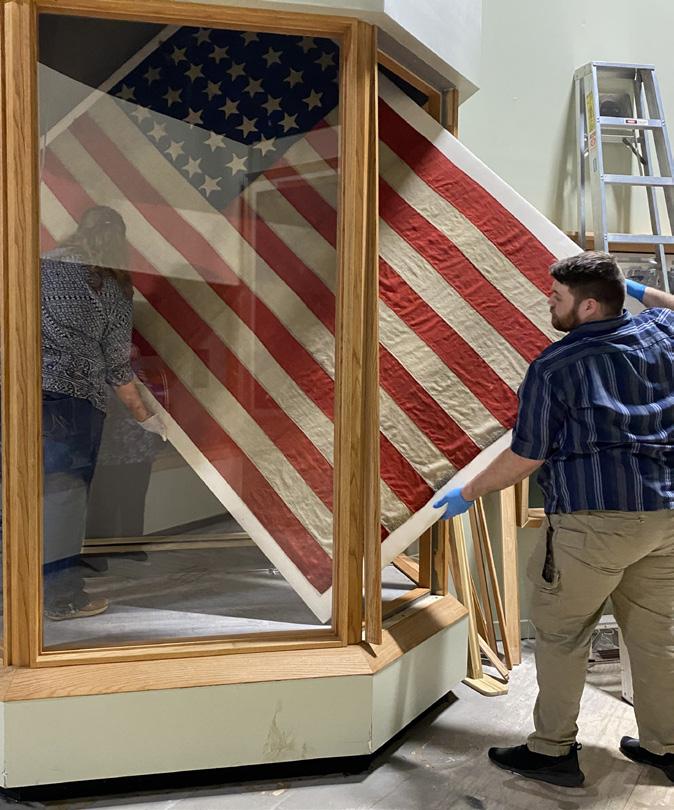
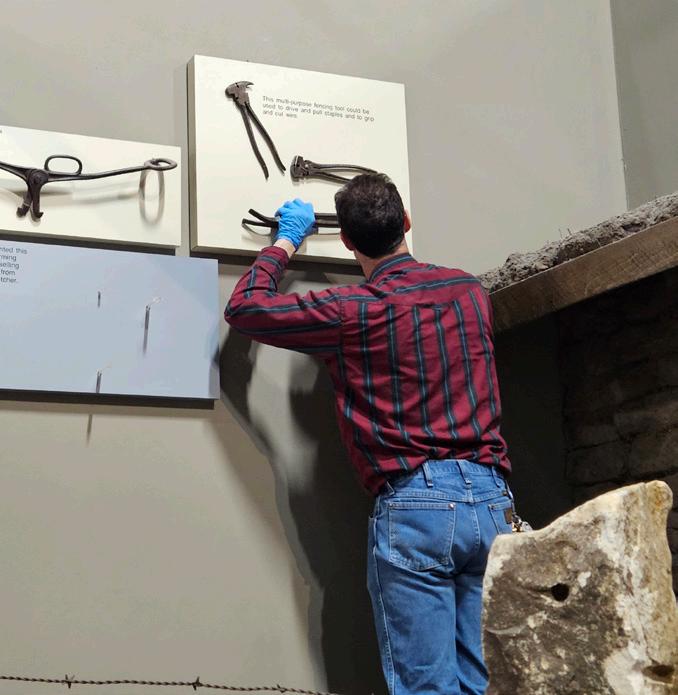
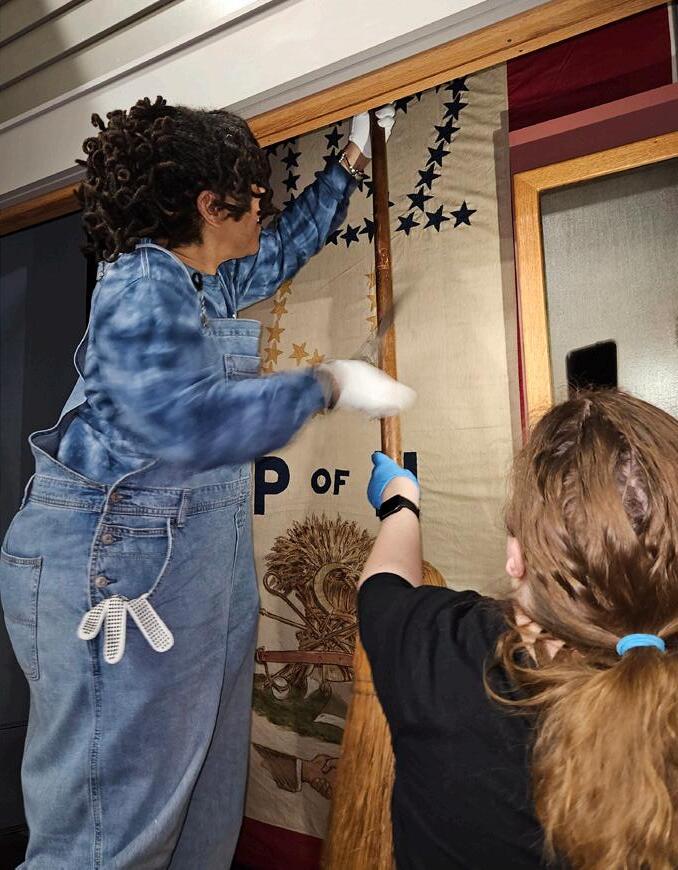
The museum received a National Endowment for the Humanities (NEH) grant that helped take advantage of the opportunity to enhance catalog descriptions and photograph these artifacts. The grant provided two temporary staff members to assist with this process.

Boone Dodson, originally from Burlingame, gained an interest in the Civil War and overland trails at an early age. That interest led him to reenacting, researching, and teaching about soldiers.
The museum project gave him the chance to apply that knowledge, working with historical artifacts, researching the stories they have to tell, and linking them to the new gallery displays. He is proud to contribute that research toward the new Bleeding Kansas and Civil War sections. 1
Donna Rae Pearson received her master’s in history from Wichita State University and considers herself a radical historian. Her research focus is on the history of African Americans in Kansas and Historic Preservation. She highly values participatory research projects that give underrepresented groups agency to tell their stories in the most accessible way possible. That led her to conduct and participate in numerous community engagement and oral history projects.
During the past 30 years, her
skills have helped her engage diverse communities in the creation and preservation of their local history, developing themed walking and driving tours for organizations. She is excited about the opportunity to contribute to new exhibits that will be more inclusive and reflective of our state’s residents. 4
2 3 5
September/October 2023 12 Zephyr
PREPARING FOR STORAGE
ONE. Robert Elder, former museum registrar (now review and compliance coordinator), removes a farming implement from the sod house display.
TWO. Museum Curator Anna Woods and Museum Specialist Boone Dodson gently remove the 34-star flag from the “Writing the Constitution” case.
THREE. With assistance from Anna Woods, Collection Development Specialist Donna Rae Pearson detaches a broom associated with the Populist Party in the Farmer’s Revolt case.
FOUR. Museum and maintenance staff move artifacts into collection storage where items are carefully housed during the museum renovation.
FIVE. Anna Woods removes items from a case on Native American history.
SIX. Boone Dodson and Donna Rae Pearson take down the Western Union Telegraph & Cable Office sign.
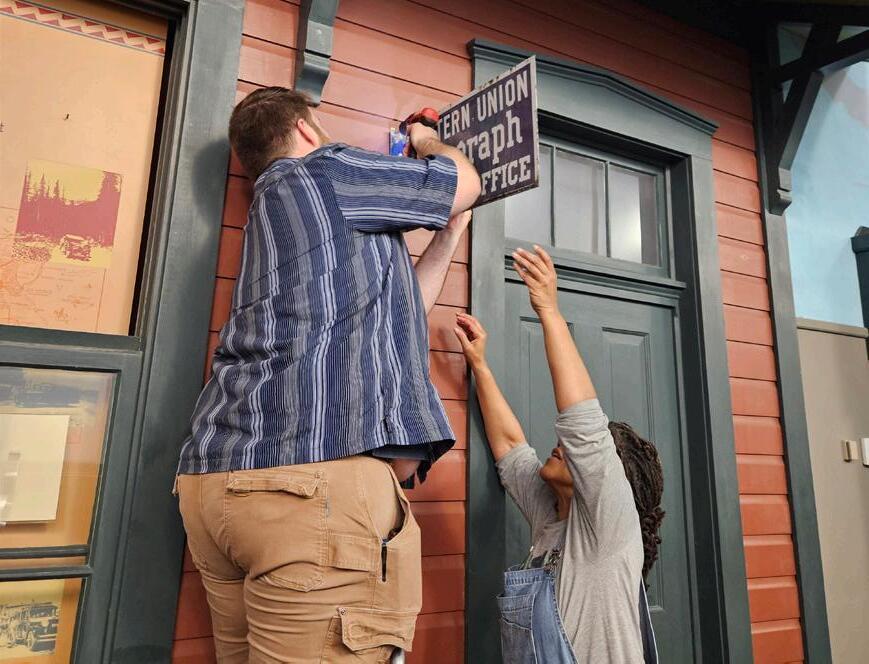
SEVEN. Anna Woods lays an 1848 oxen yoke on a cart in preparation for its transport to storage.
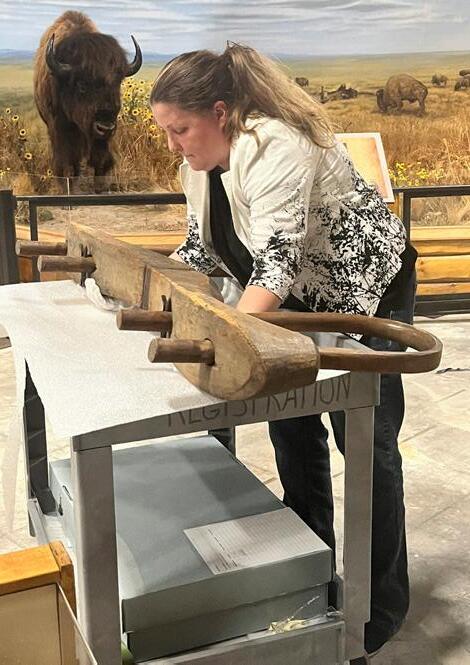
EIGHT. Robert Elder, Chris Pugh, and Joe Krivenko carefully move the 1856 David C. Buffum headstone.

NINE. Chris Pugh and Exhibit Director Nate Forsberg dismantle the reproduction of a 1920s Phillips 66 gas pump.
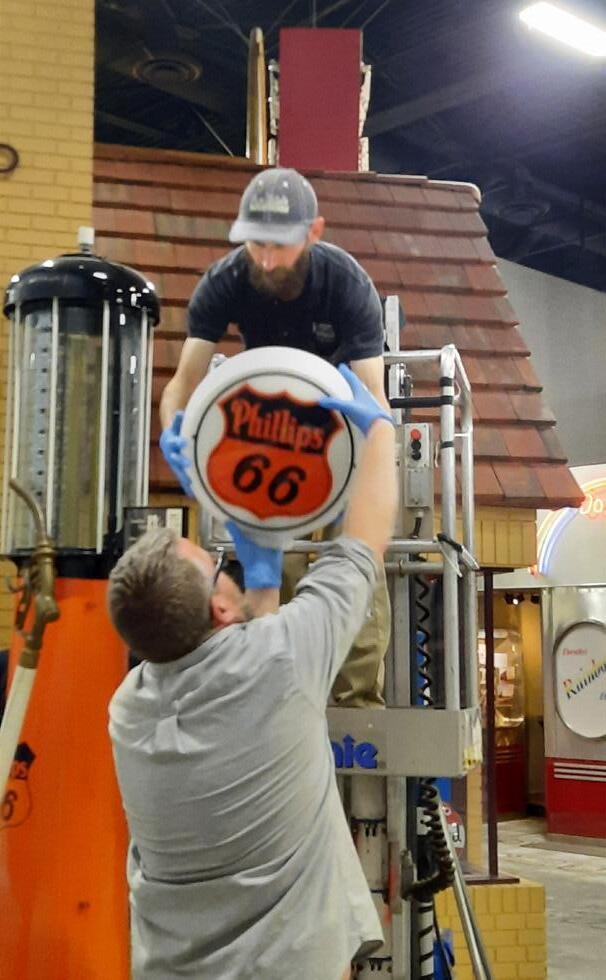
For more museum renovation updates, scan this QR code. ->

MUSEUM RECEIVES DEVELOPMENT GRANT
We are excited to receive a $40,000 Kansas Tourism Attractions Development Grant, presented in May. The grant will supplement the visitor experience on the train. From left, Derenda J. Mitchell, Kansas Historical Foundation executive director and CEO; Sarah Bell, Museum and Education division director, Kansas Historical Society; Patrick Zollner, Kansas Historical Society executive director; and Bridgette Jobe, Kansas Tourism division director.
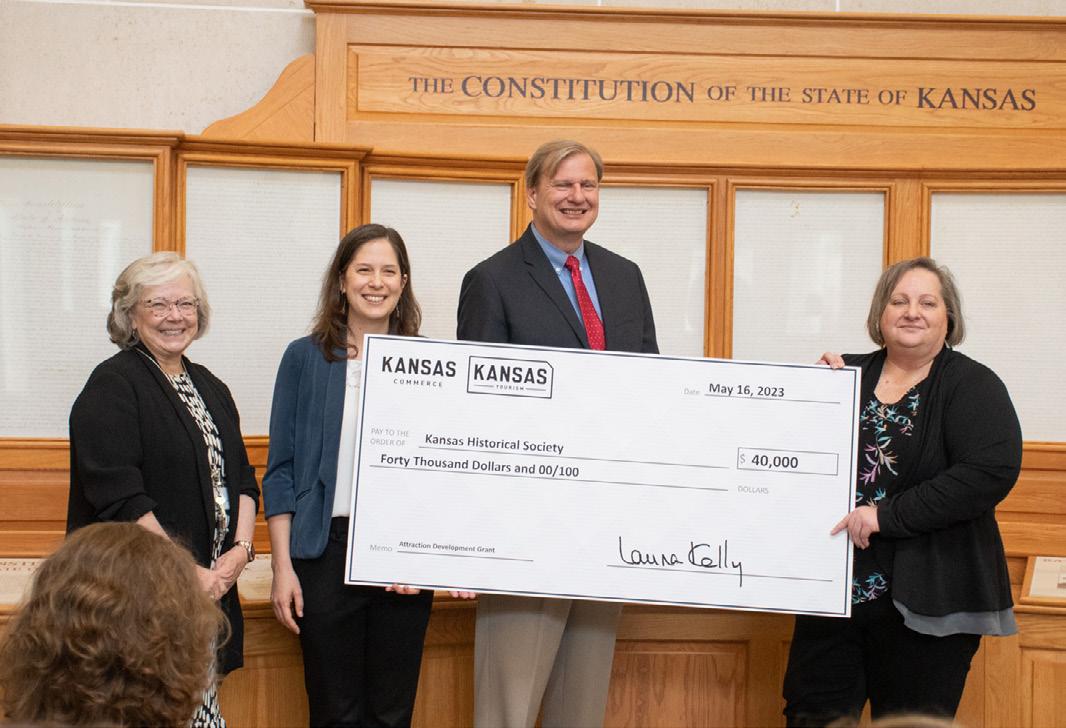
Kansas Historical Society Zephyr 13
7
8
9
6
STATE ARCHIVES
Collecting, preserving, and providing access to the state’s history through unpublished materials, personal papers, audio-visual materials, and government, organization, and business records.
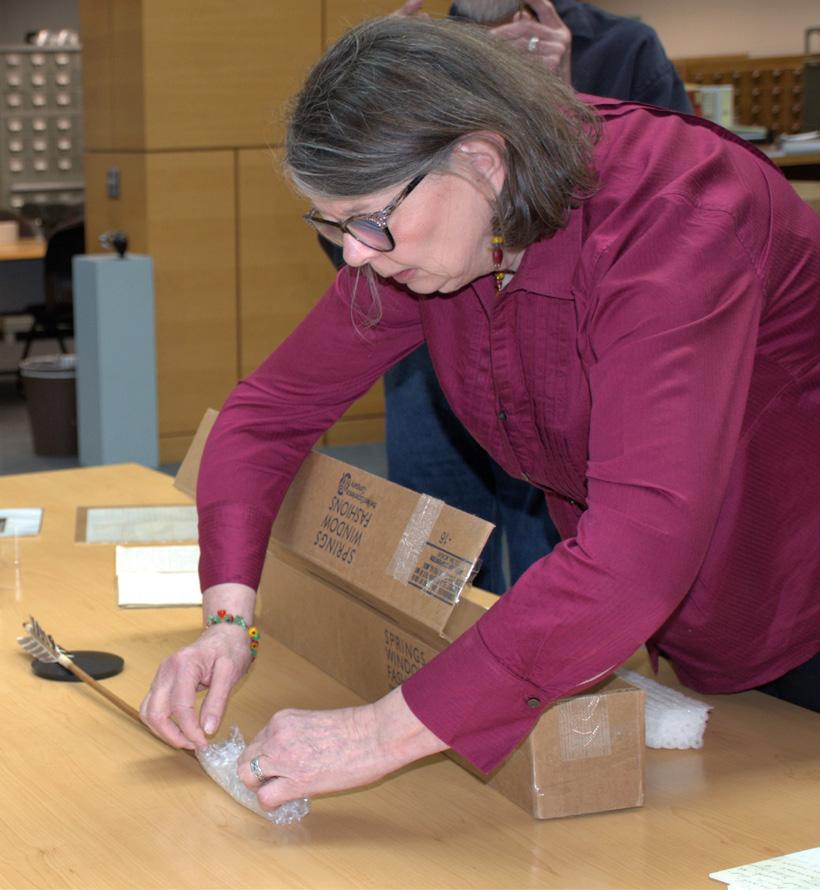
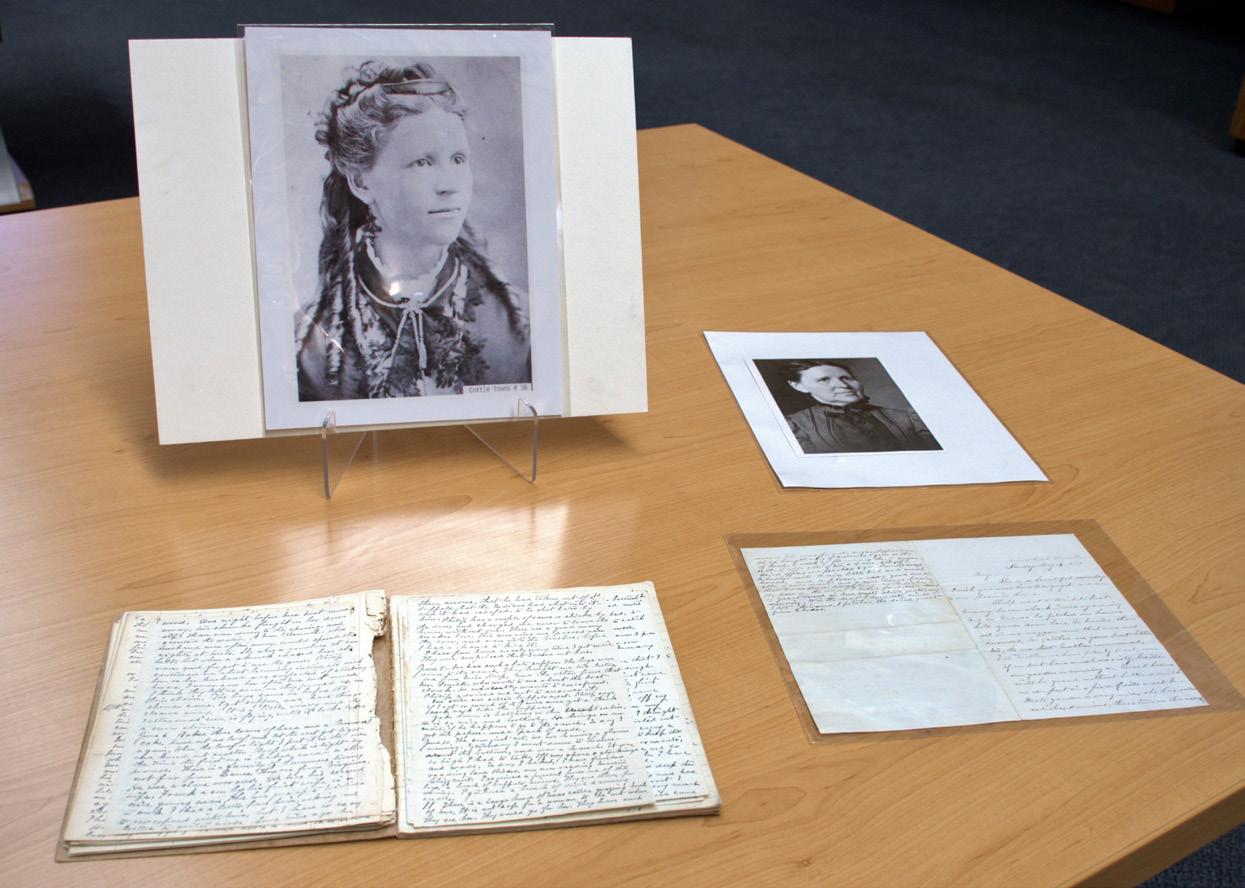
1
Adding to the Story of Abbie Bright
By Lauren Gray, Head of Reference
Abbie Bright is a name many Kansas Memory users might recognize, if only because her writing was so extensive that she often shows up in searches. But Abbie is more than a touchstone in our catalog—she was a vivacious and independent young woman at a time when it was rare for women to wander so far afield.
It is also one of history’s small ironies that her surname so aptly described her: bright, as well as bold, daring, yet with an eye for quiet detail and a knack for assessing her own character. In attitude, Abbie was a conventional 19th century woman, but in action, she was startlingly unconventional, and it is this dichotomy that makes Abbie and her diary an enduring
historical resource.
Born in Danville, Pennsylvania in 1848, Abbie worked as a teacher after she finished school. In 1871, she traveled to Indiana and Kansas to visit her brothers, who had struck out West after the Civil War. Abbie kept a diary during her trip, and recorded her thoughts and feelings, as well as vivid descriptions of her journey and details of her encounters with people on the frontier. Even twenty years after becoming a state, Sedgwick County was rural and sparsely settled.
During her time in Kansas, Abbie’s brother, Phillip Bright, encouraged her, as an unmarried woman, to utilize the Homestead Act to invest in 160 acres of land in Sedgwick County.
From her diary, April 1871: Brother Philip wrote his address is Wichita Kans. He had spent the winter in Kans. and Indian Territory. He says … if I want to come west, I can take up Government Land, and after living on it six months, can prove up on it by paying $1 1/4 an acre for it. He took up a claim some time ago, and if I go—I can stay with him, his house is almost finished. I am only to take heavy strong clothing, and what ever I will want for a bed. The rout is via Quincy— Kansas City, Topeka, Emporia—There a stage runs to Wichita, where he will meet me… If I decide to go, I shall do so at once. … I wonder what mother will say, when she hears I am going to Kans.
September/October 2023 14 Zephyr
2
Abbie’s time in Kansas was marked by extreme weather, ague, and the rigors of frontier life. The only thing she craved more than mail from home was flour to make bread. She spent much of her time doing domestic tasks at her brother’s cabin. She made lasting friends, including Frank, a young man who lived in Wichita and who asked permission to write to her. While Abbie does not confirm if she agreed, Frank was a doting figure during her time in Kansas.
From her diary, June 1871: Frank gave me three arrows that had been shot into a buffalo. Last winter when out hunting they shot a buffalo that the Indians had been chacing [sic], and there were seven arrows sticking in him, and he gave me three. I think them quite a curiosity. It was not easy for the Indians to kill a buffalo, unless they shot them in the eye or back of the front leg in the heart. Their skull is so thick an arrow glances off.
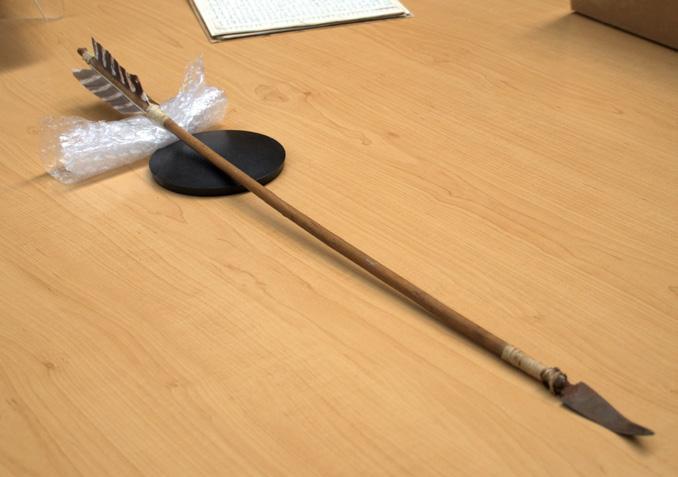
Unlike many settlers in Kansas, Abbie did not intend to stay forever. Despite her fondness for the new state and the many friends she made during her stay, she lived in Kansas less than a year. Abbie eventually resettled in Iowa. She married William Achenback in 1873 and became
4 3
an active and beloved member of her community. Abbie’s diary and correspondence passed down to her grandson, who donated them to the Kansas Historical Society.
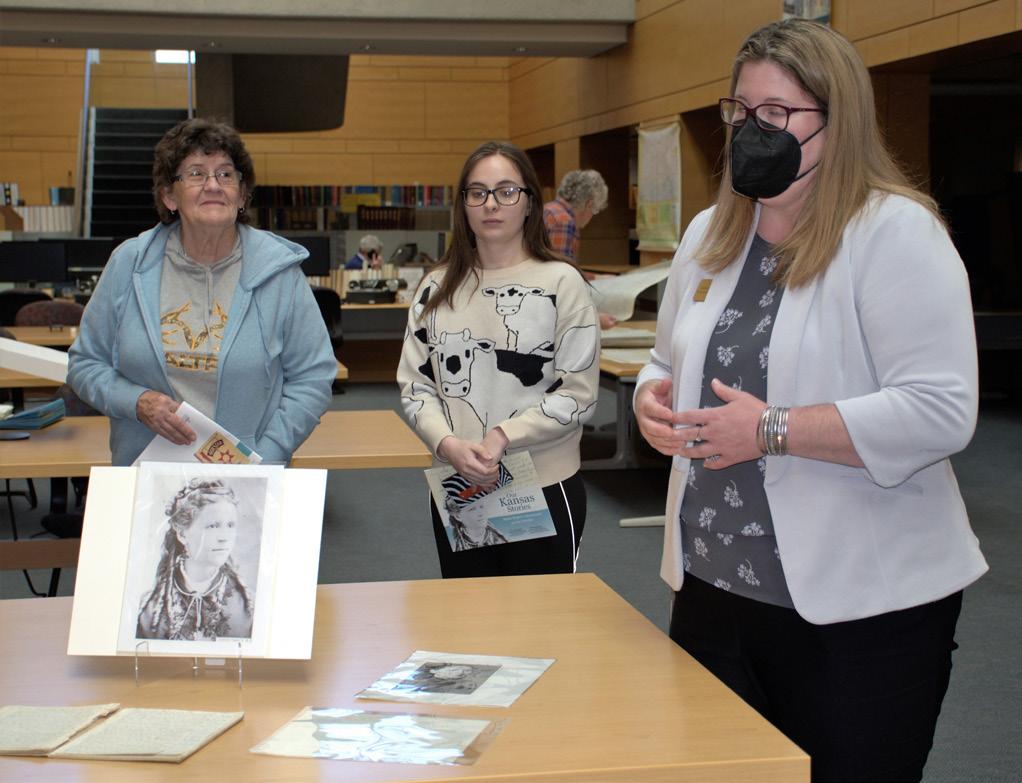
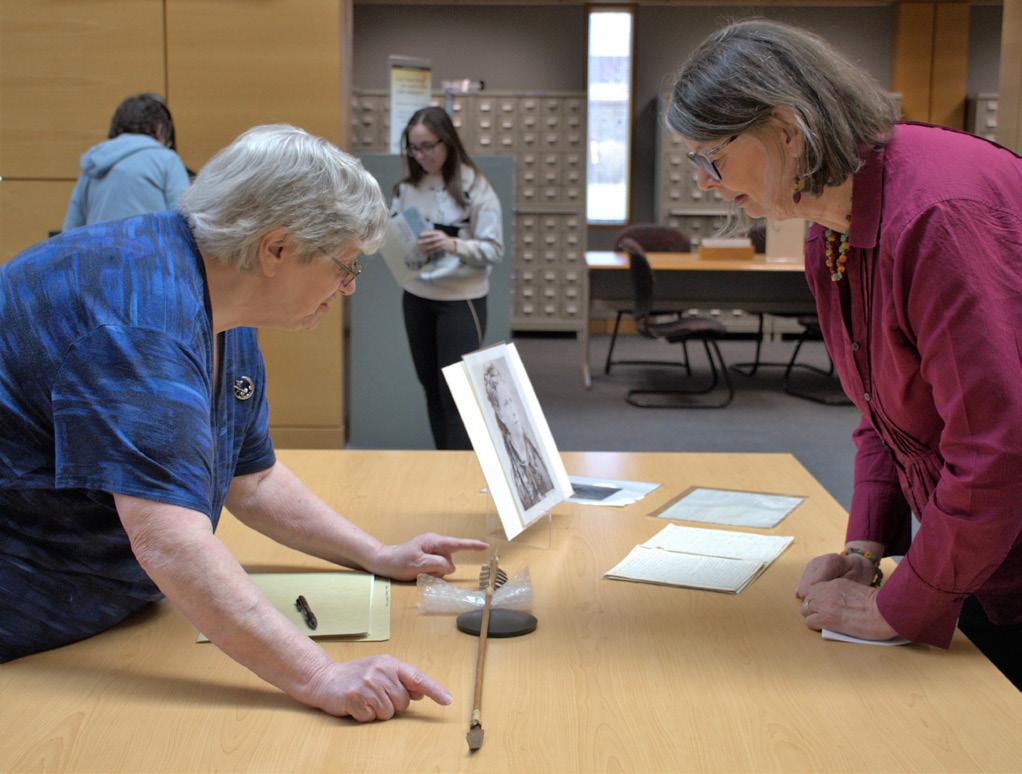
TWO.
From her diary, November 1871: Now I have had the last look at my Kansas claim, and the dug out. Where I spent many weeks. I felt real sorry to leave. As I stood alone by the dug out— no one in sight, no visible sign of civilization… I felt depressed, I was so glad to be with Philip for over seven months. Now I was leaving, when would I see him again?... I do not like changes. History catches up with us in interesting ways. Earlier this year, Director Sarah Dougherty of the Beaman Community Memorial Library approached
Chris Garst, Kansas Historical Society archeologist, about the arrowhead Abbie had acquired during her stay in Kansas. Whether it was the gift from Frank, or something she purchased as a souvenir while in Kansas, after her death, the arrowhead had passed to her descendants and stayed in Iowa, while her papers had journeyed, again, to Kansas. The Beaman Community Memorial Library, with the permission of the donor’s family, transferred custody of the arrowhead to the Kansas Historical Society on April 7, 2023. After over 150 years, Abbie’s arrow is home.
To read more about Abbie Bright and her time in Kansas from her diary, scan this QR code. ->

Kansas Historical Society Zephyr 15
ONE. Photos of Abbie Bright and excerpts from her diaries that chronicle her life in Kansas set on display in the reference room at the Kansas Historical Society.
Sarah Doughtery, director of the Beaman Community Memorial Library, carefully unwraps the arrow that once belonged to Abbie Bright.
THREE. Lauren Gray, head of reference, gives visitors a synopsis of Abbie Bright’s life and her Kansas connection.
FOUR. Chris Garst, archeology lab supervisor, examines the Abbie Bright arrow with Sarah Dougherty.
Taking Inventory: Audio/Visual Collections
Thehistoric sound and visual analog recordings in the State Archives are varied. They span motion picture film, wax audio cylinders, transcriptions discs, LP discs, magnetic audio/ videotape, wire recordings, and instantaneous audio recordings.

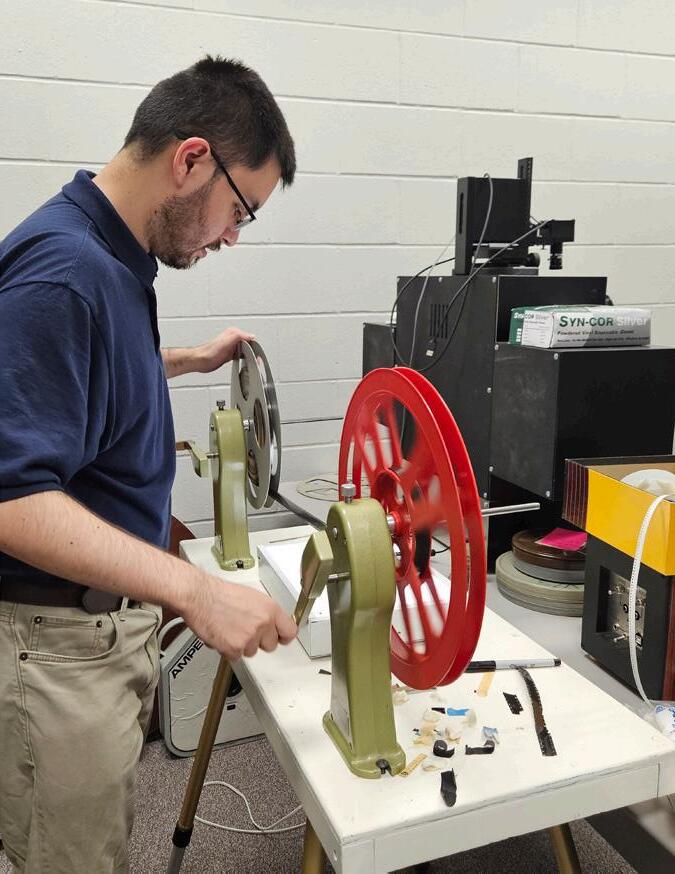
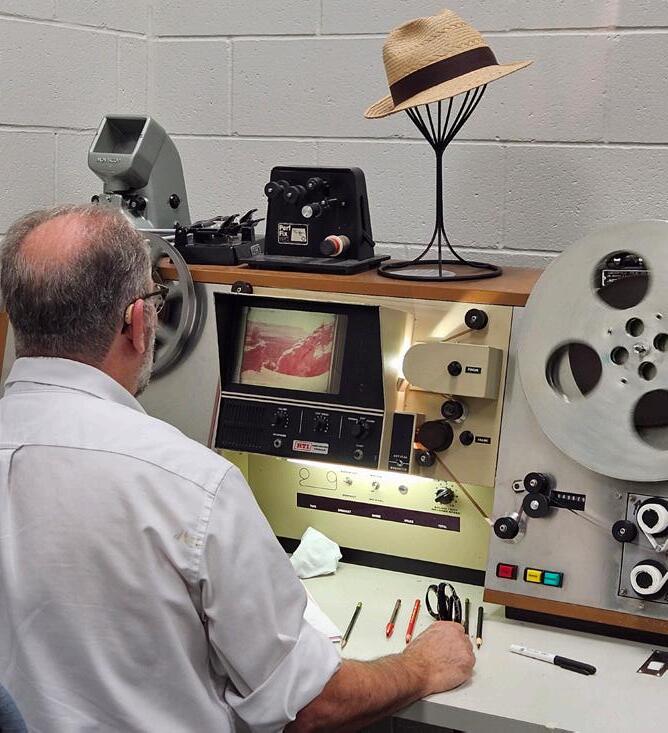
The National Endowment for the Humanities (NEH) grant provided three temporary staff members to inventory this valuable collection. More than 7,000 new descriptions have been added to the Archives Catalog.
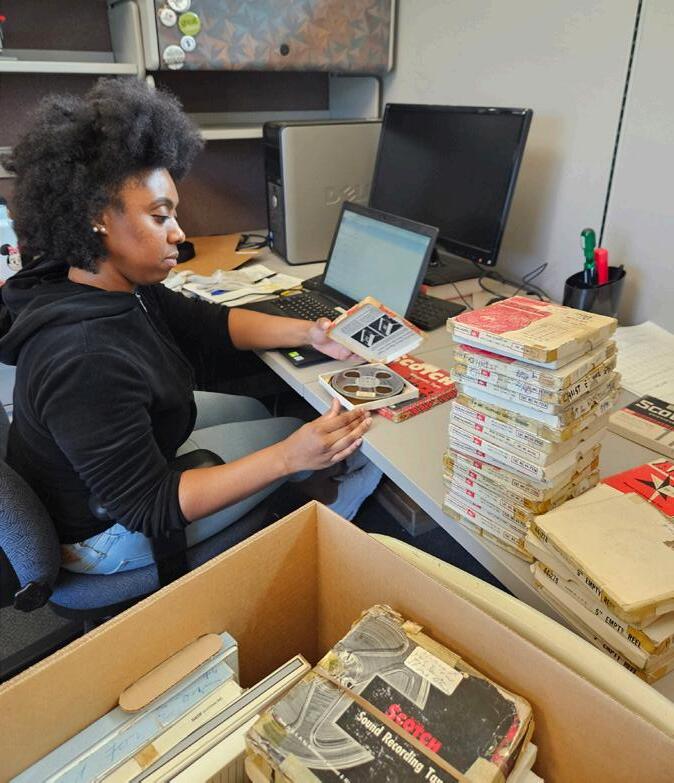

Darrell Garwood of Topeka retired after 38 years with the Historical Society, most recently as senior archivist, in 2020. He returned to lead the project team relying on his extensive knowledge of the audio/visual collections and preservation protocol.
Unique Grady of Topeka earned a bachelor’s degree in anthropology with a history minor from Washburn
University. She plans to study Mesoamerican archeology in graduate school.
She examined news reels from Kansas television stations--KAKE, WIBW, and KSNT—as well as collections related to political and spiritual leaders like Frank Carlson, John Brinkley, and Clifford Lewis. She enjoyed discovering how these materials shed light on the past in many different ways.
Marc Tsuno, from California, earned a bachelor’s degree in history at the University of California, Santa Barbara, where he grew to love historical objects and materials. He previously worked at the National Buffalo Museum in Jamestown, North Dakota. He has helped process many collections during the project,
including the Atchison, Topeka, & Santa Fe Railways Film. He is pleased to know his work will increase the visibility and accessibility of these rich collections for researchers and the public.
The Kansas Historical Society is celebrating Archives Month in October. Visit our research room to explore resources on Kansas history and the West! Genealogy, house history, state history, and community records are among the favorite topics to explore. The collections include photographs, maps, manuscripts, newspapers, state records, and numerous other materials. To view our current hours and prepare for your visit, scan the QR code. ->
September/October 2023 16 Zephyr
Research Room
Marc Tsuno
Unique Grady
Darrell Garwood
STATE HISTORIC SITES
Preserving and protecting the state historic sites placed under the care of the Historical Society; educating visitors and classrooms through exhibits, exterior interpretation, and programming.
Presenting: Kaw Mission and Last Chance Store
Westwardexpansion reached Council Grove in the mid to late 19th century, bringing an intersection of cultures to this place. Here on lands of the Kanza came the Santa Fe Trail, international traders, miners and prospectors, and settlers heading west, all as the nation was moving closer to civil war. Kaw Mission and Last Chance Store Museums are newly reinterpreted to tell these stories with new displays, interactive elements, and short informational films.
Built in 1850 as part of the U.S. Indian civilization and education effort, Kaw Mission was operated by Methodist missionaries to board and teach Kanza boys who had been moved to the reservation in Council Grove in 1846.
New displays in the mission will help visitors understand the impacts of westward expansion on the Kanza—the forced relocation, this controlled educational environment, changes in their way of life, and
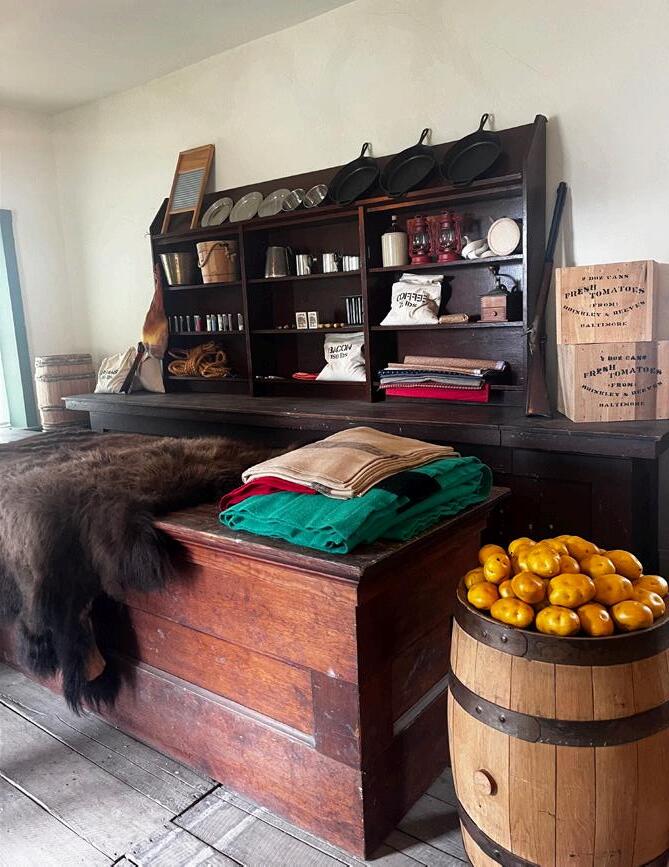
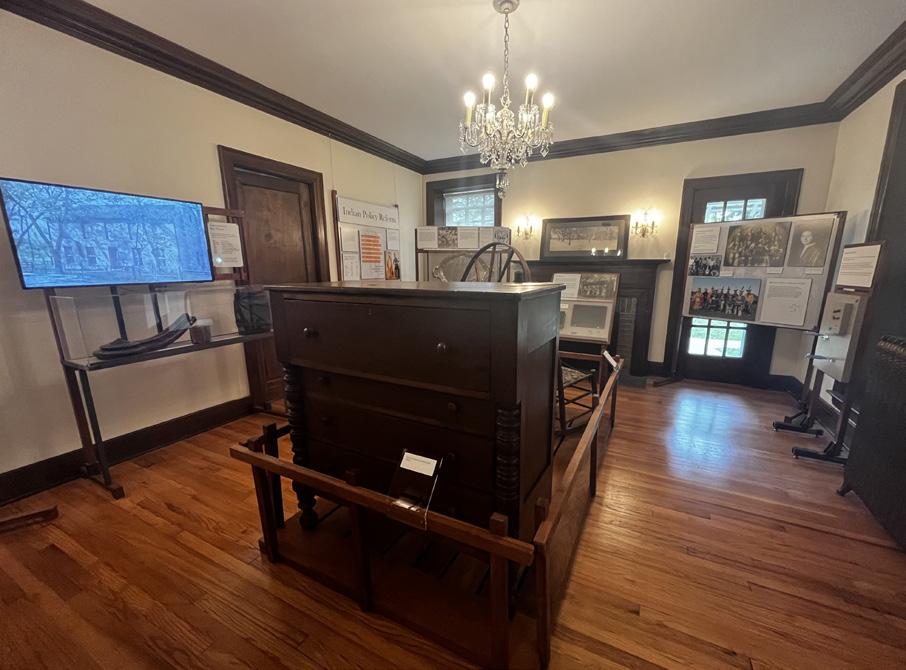
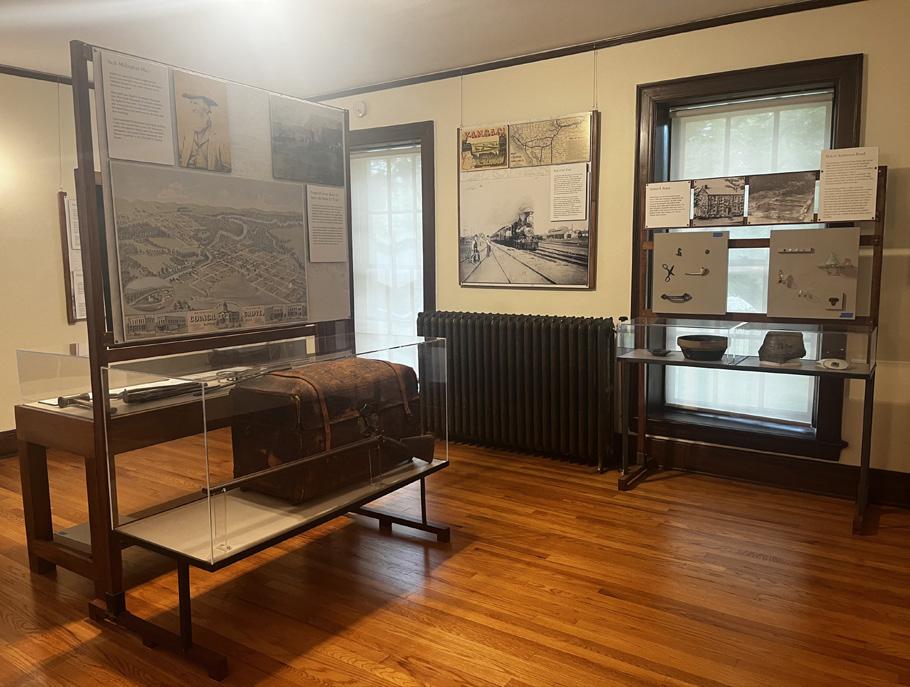
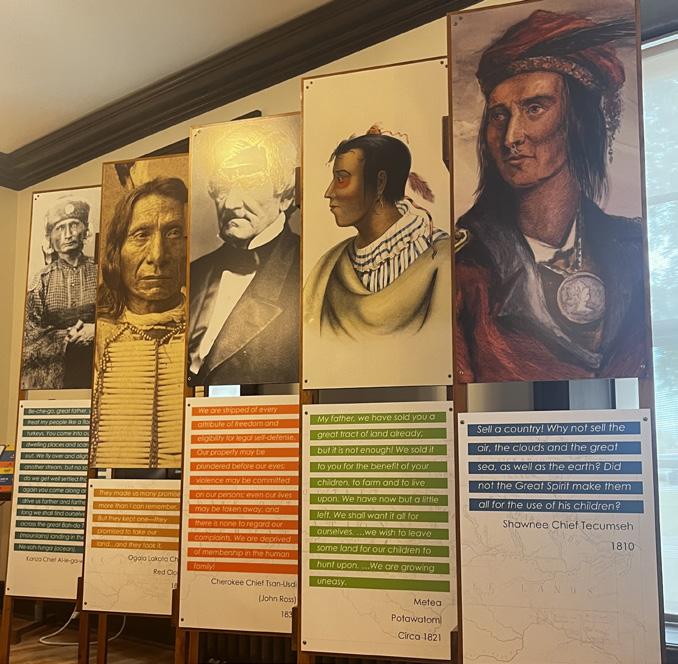
eventual forced move to Indian Territory, now Oklahoma.
Built in 1857, the Last Chance Store, the only original and intact trading post in Kansas, supplied bacon, beans, and whiskey to traders from the East and from Mexico on the long route connecting Santa Fe to Missouri. Visitors will be able to schedule a tour of the store at the Kaw Mission visitor center. Opening plans are underway for Saturday, September 16, 2023. Mark your calendar and check our social media for the latest updates, map, and schedule of events (or scan the QR code below).
SPECIAL OPENING EVENT SATURDAY SEPTEMBER 16
Kaw Mission and Last Chance Store State Historic Site Council Grove
620-307-2754
kshs.kawmission@ks.gov
For more about the reopening, scan this QR code. ->

Kansas Historical Society Zephyr 17
AUTUMN TRAVEL IN KANSAS HISTORY
We invite you to plan a trip to explore history and enjoy free admission at the Kansas State Historic Sites. These sites around the state tell local and national stories about Native Americans, agriculture, Bleeding Kansas, Civil War, and forts and trails. Several of our sites are seasonal and will be closing soon; hours and days of operation vary by site, closed state holidays.

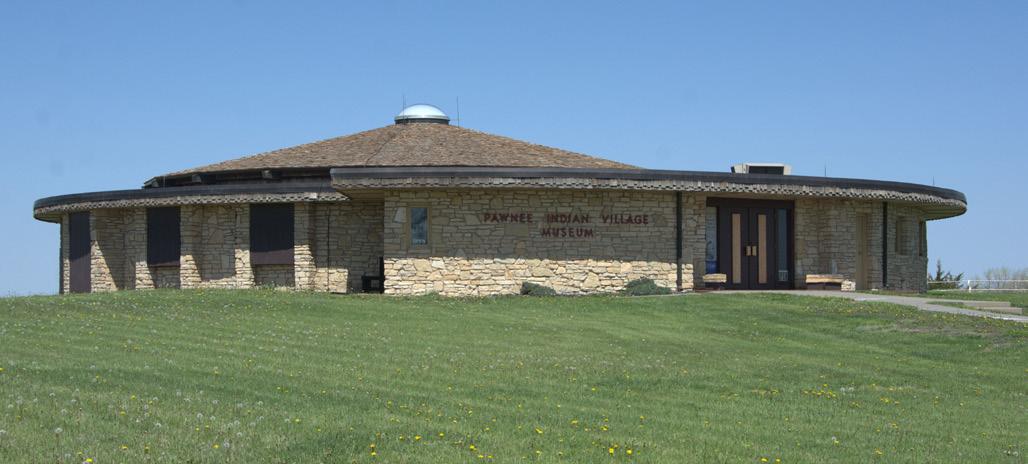
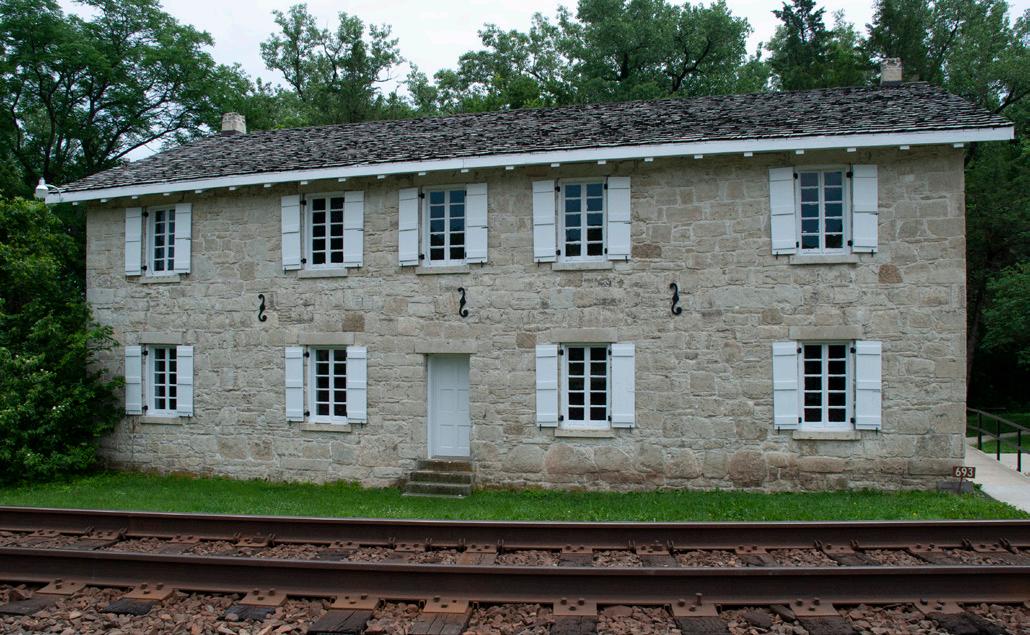
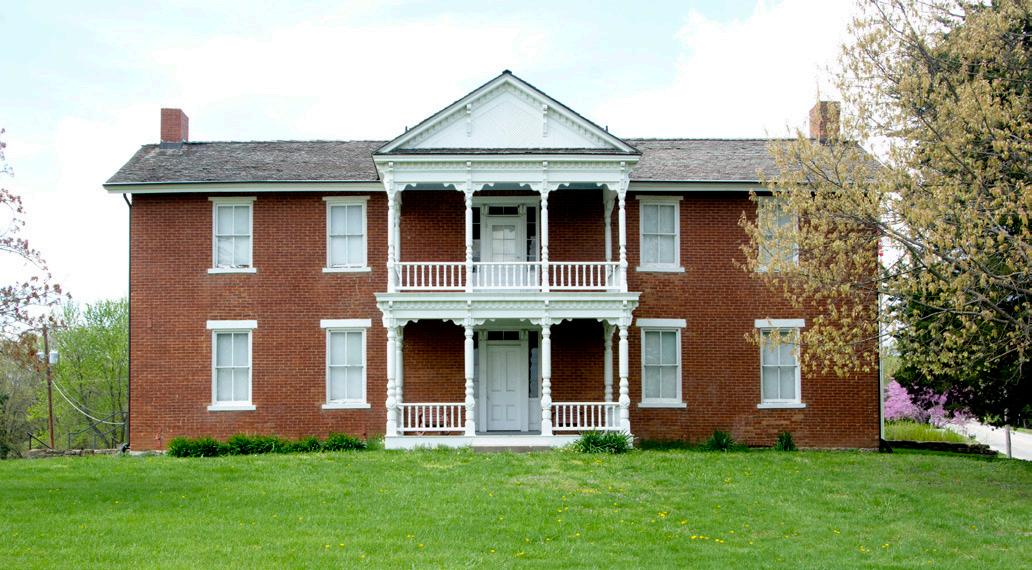
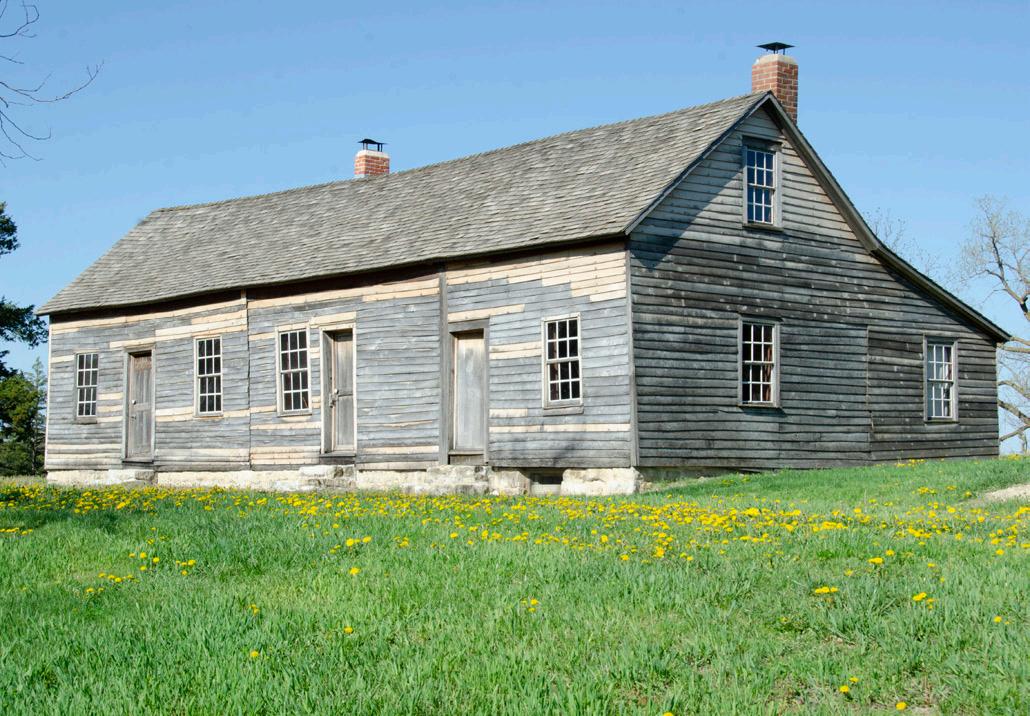

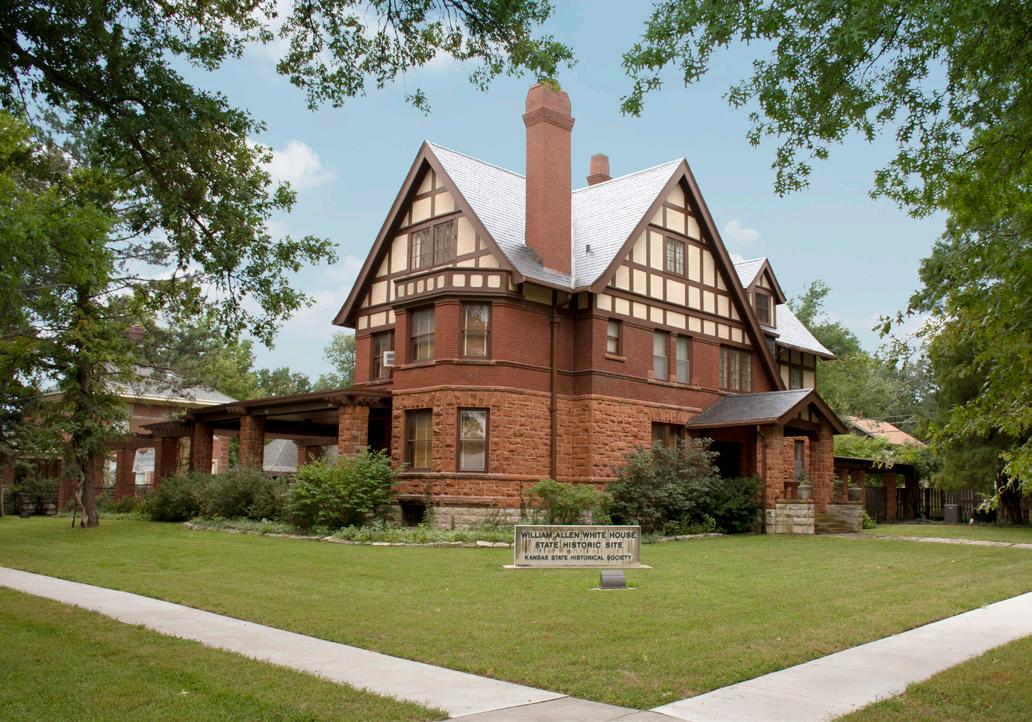
CLOSES OCTOBER 14, 2023







September/October 2023 18 Zephyr
RED ROCKS EMPORIA
COTTONWOOD RANCH STUDLEY
HOLLENBERG PONY EXPRESS STATION HANOVER
GRINTER PLACE KANSAS CITY
FIRST TERRITORIAL CAPITOL FORT RILEY
1 2
PAWNEE INDIAN MUSEUM REPUBLIC
4 3 5 6
MINE CREEK CIVIL WAR BATTLEFIELD PLEASANTON
7
2 4 1
5 3
CLOSES OCTOBER 14
OPEN YEAR ROUND
OPEN YEAR ROUND
Constitution Hall - Lecompton
Fort Hays - Hays
Goodnow House - Manhattan
John Brown Museum - Osawatomie
Kaw Mission and Last Chance StoreCouncil Grove (opening September 16)
Marais des Cygnes Massacre - Trading Post (self-guided site)
Pawnee Rock - Pawnee Rock (self-guided site)
Shawnee Indian Mission - Fairway
To learn more history, view the current hours, and plan your next visit to our seasonal or year round sites, scan this QR code. ->

7







Kansas Historical Society Zephyr 19
70 70 35 335 135
HISTORY
6
On this Day in Kansas History
9/2
Albin K. Longren’s first successful flight happened on this day in 1911. Longren was born in Leonardville (Riley County) and as a young boy dreamed of flying. With the help of his brother William, Longren crafted a push-type biplane. After a few attempts, the plane became airborne. He flew as a barnstormer throughout the Midwest and became known as the “Birdman.” Funded by his barnstorming income, Longren built his aircraft manufacturing factory in Topeka. It was the first aviation company in Kansas. By 1923, the company had produced 21 planes, but was forced to close in 1926 due to lack of funding and few sales. The only known surviving Longren aircraft is a pusher-type biplane on exhibit in the Kansas Museum of History’s main gallery.
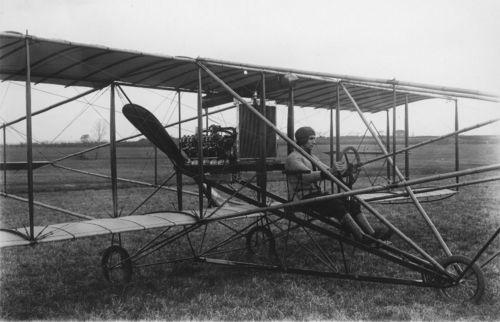
On this day in 1867, the first load of cattle was shipped by rail from Abilene, Kansas. The Union Pacific Railway, Eastern Division (known as the Kansas Pacific in 1869) connected Abilene to packing plants in Kansas City, Chicago, and other eastern cities. The town received approximately 35,000 head of cattle that first year. Joseph McCoy, a cattle dealer from Illinois, helped lead the way in making Abilene an ideal rail head for Texas cattle. Under his leadership, Abilene prevailed as the primary market for Texas cattle for four years. Increased settlement in Abilene forced the cattle market to move west to Newton, Ellsworth, and Dodge City.
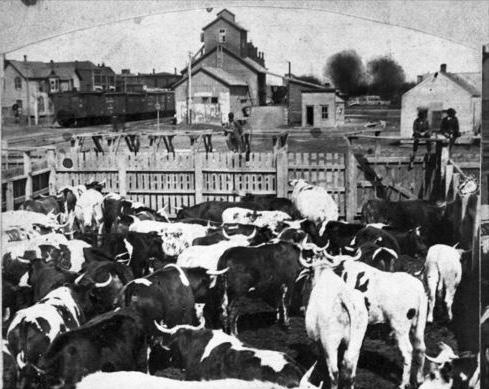
9/16
9/5
Garden City’s Community Mexican Fiesta is held annually around the second weekend in September to commemorate Mexico’s Independence Day on September 16. The first event, “La Fiesta,” was organized in 1926 and also marked the end of harvest for the Hispanic farm laborers who had settled the area. As one of Kansas’ first community fiestas, people from all over the state traveled to Garden City to join the festivities. Behind the bright carnival lights, the sounds of the mariachi band, and the aroma of cumin and chili powder wafting through the air, lie a story of a culture passing on its traditions from one generation to the next. The word “fiesta” means a happy, joyful celebration, and in many Kansas communities it signifies one or several days of traditional music, folkloric dancing, parades, food, games, and crafts. While they often involve fundraising events for churches and schools and include the coronation of a Fiesta queen, they are ultimately an opportunity for the Hispanic community to celebrate and share its rich traditions.
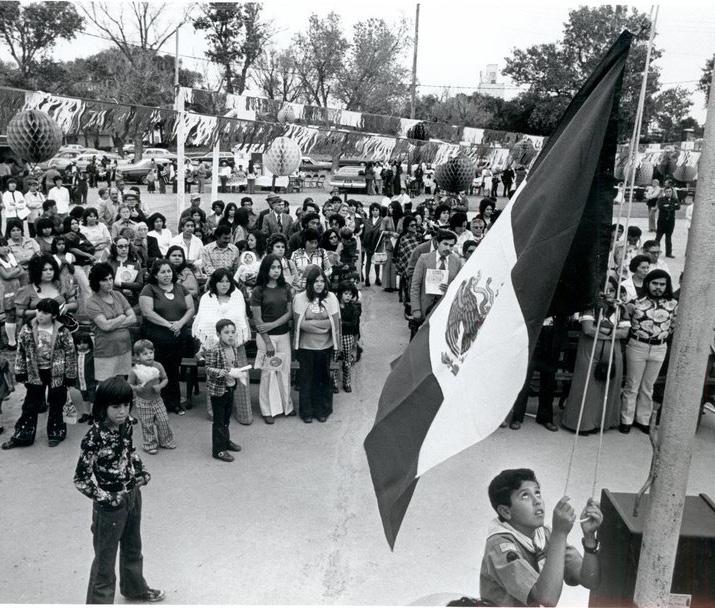
September/October 2023 20 Zephyr
African American settlers arrived in Nicodemus on this day in 1877. Thousands were eager to leave the post-Civil War South in search of a new life. By the summer of 1877, many were convinced to move to Graham County and the new town site of Nicodemus was established. After the first wave of 350 settlers arrived, Nicodemus grew rapidly. Several Black-owned businesses thrived, and the town eventually became the center of Black culture in the region. After World War I the town’s population began to decline. Today Nicodemus survives a small community and can boast being the longest-lasting African American settlement in the state. A Homecoming celebration is held here annually in late July, where descendants from across the country gather to honor their history and heritage.
Joseph Frank “Buster” Keaton was born on this day in 1895 in Piqua (Woodson County). Keaton began performing with “The Three Keatons,” his parent’s vaudeville act, at the age of three. His father taught him how to fall so he wouldn’t hurt himself while performing. Keaton went on to be a silent film star and director, appearing in movies such as “Three Ages,” “Sherlock, Jr.,” and “Go West.” Because of his deadpan expression, he earned the nickname “The Great Stone Face.” Later in his career, Keaton made several movie and television appearances. He died in Los Angeles on February 1, 1966.
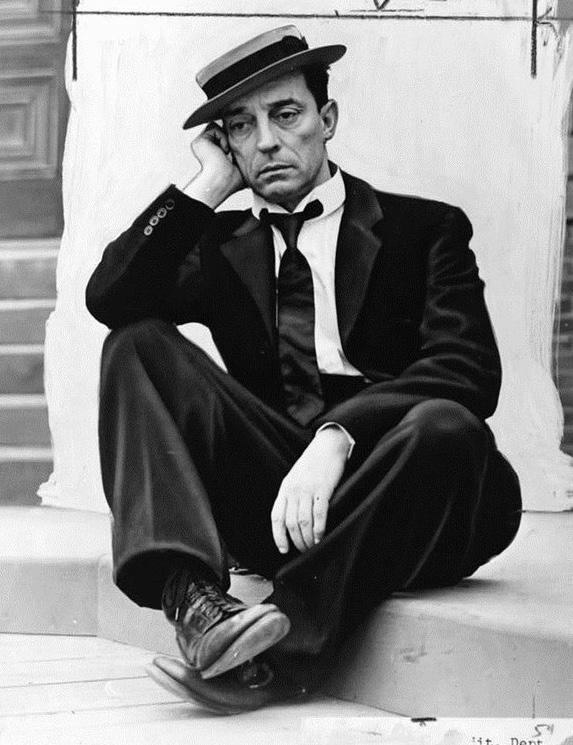
Today in 1892, the Dalton gang held up two banks in Coffeyville (Montgomery County). Bob and Emmett Dalton went to the First National Bank while the rest of the crew entered the C. M. Condon and Company Bank. When people realized the banks were being robbed, a shootout ensued between the gang and citizens with the aid of the town’s lawmen. Bob and Grat Dalton and two other gang members were shot and killed as they tried to escape. Emmett Dalton was wounded, captured, and sentenced to life imprisonment in the Kansas State Penitentiary in Lansing. He served 14 years before being pardoned. He moved to California where he died in 1937 at the age of 66.
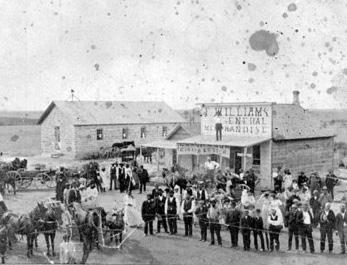
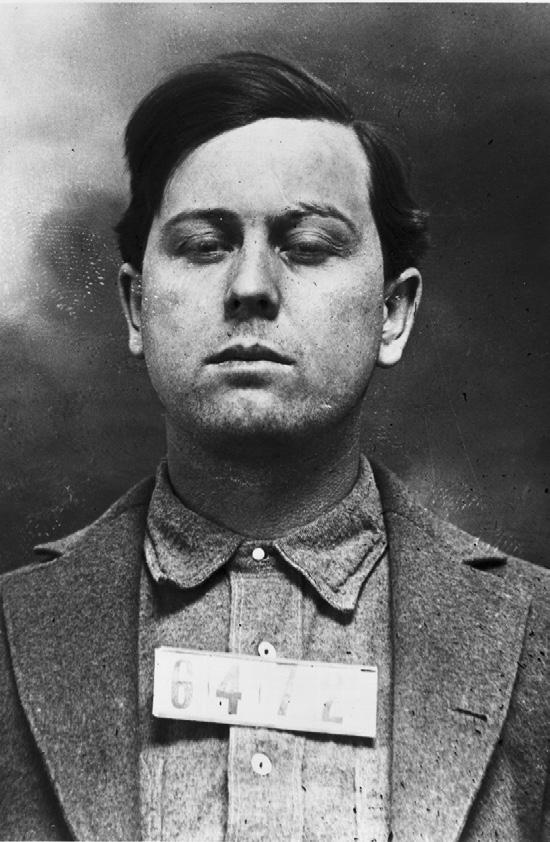
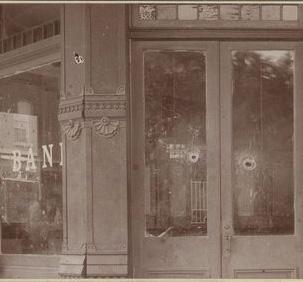
Kansas Historical Society Zephyr 21
9/17
10/4
10/5
NEWS and NOTES
Summer Interns and Staff Members at the Historical Society
Ivan Tidwell, archives intern, processed a large collection of materials from The Land Institute, a non-profit education and research organization located near Salina. Tidwell, an undergraduate student at Park University in Parkville, Missouri, met course requirements for a class in history through the internship.
Debbie Stanton, Museum and Education intern, cataloged museum artifacts, including a large recently donated milling collection. Stanton is pursuing a certificate in museum studies from the Institute of American Indian Arts. She is manager of the Alice C. Sabatini Art Gallery at the Topeka Public Library and has worked 15 years as a professional librarian.
Anna Anderson, Cultural Resources intern, identified documented historic places tied to underrepresented groups. These included civil rights-related properties in Lawrence and the Carver Social League in Pittsburg. Anderson is a student in anthropology and history at Washburn University in Topeka.
The new Amelia Earhart Hangar Museum in Atchison, which opened in April, offers an exciting new experience for those interested in Kansas aviation history. The impressive centerpiece of the museum, the restored Lockheed Electra 10-E, is named Muriel for Amelia Earhart’s sister Grace Muriel Earhart Morrissey. This museum provides a complementary experience with the Amelia Earhart Birthplace Museum in Atchison, listed in the National Register of Historic Places.
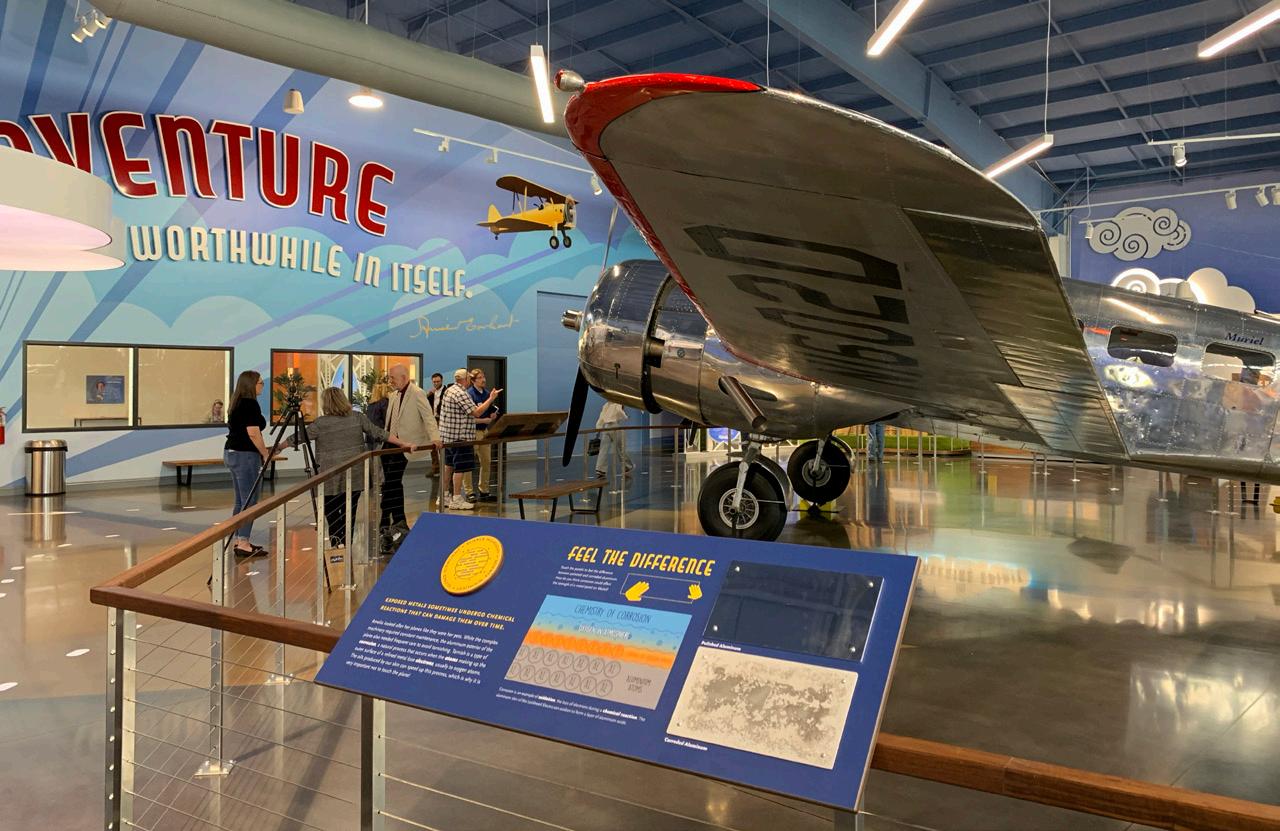
Kansas 250
Deekshitha Kalluri joined the staff part-time this summer, contributing greatly to data management for the new exhibits planning. In addition to assisting at the front desk, answering phones and greeting guests, she helped with efficiencies and organization as staff members sort and select artifacts and archival materials for the new museum galleries. She is a senior majoring in business analytics and information systems at the University of South Florida.
Kansas joined many other states in planning for the nation’s milestone 250th anniversary in 2026. The Kansas Commission for the U. S. Semiquincentennial is a statelevel organization creating a series of events and experiences for Kansas citizens to inspire American spirit. Members of the commission represent a breadth of interests including education, history, and law and will seek input from Kansans across generations, geographies, and backgrounds to develop programming that appeals to all. The Kansas Historical Society and Kansas Historical Foundation are pleased to serve on this important commemorative commission, which began meeting in May.
September/October 2023 22 Zephyr
Amelia Earhart Hangar Museum
Upcoming Events...
See more events by scanning the QR code to the right ->

SEPTEMBER
4 - Statewide
Labor Day, all sites closed for the state holiday
10 - Emporia
Red Rocks Sundays on the Porch “A Visit with Sallie White,” 2 p.m. Sunday, presented by Barbara Fowler
13 - Virtual Museum After Hours – 6:30 p.m. Wednesday, via Zoom and YouTube
16 - Council Grove
Kaw Mission and Last Chance Store State Historic Site opening
17 - Council Grove
Kaw Mission Councils “The Last Stand at Rebel Creek: The Osage as Union Allies in the Civil War,” 2 p.m. Sunday, presented by Isaias McCaffery
18 - Topeka
Freedom’s Frontier Partner Meeting, Brown v. Board of Education National Historic Park, Topeka; freedomsfrontier.org/partners/ 24 - Emporia
Red Rocks Sunday on the Porch “Poetry on the Porch XVI,” 2 p.m. Sunday, presented by Kevin Rabas
OCTOBER
11 - Virtual Museum After Hours – 6:30 p.m. Wednesday, via Zoom and YouTube
16-18 - Dodge City
Kansas Tourism Conference –travelks.com/ travel-industry/events/kansas-tourismconference/
NOVEMBER
3 - Newton
Kansas Historical Foundation Annual Meeting,
1:30 – 4 p.m. Friday
4 - Topeka
Kansas Historic Sites Board of Review, quarterly meeting, 9 a.m. – 12 p.m. Saturday
6-8 - Hays
Kansas Museums Association Conference, ksmuseums.org/category/conference
8 - Virtual Museum After Hours – 6:30 p.m. Wednesday, via Zoom and YouTube
22 - Council Grove
Kaw Mission Councils “Hispanic Traders on the Santa Fe Trail,” 2 p.m. Sunday, presented by Celeste Dixon
10 - Statewide
Veteran’s Day, all sites closed for the state holiday
11 - Kansas City
Grinter Place Second Saturday Sessions, 10 a.m. Saturday, presented by Kendall D. Gott, retired army officer and American military historian
13 - Lawrence
Freedom’s Frontier Partner Meeting, Carnegie Library; freedomsfrontier.org/partners/
23-24 - Statewide
Thanksgiving, all sites closed for the state holiday
Kansas Historical Society Zephyr 23
Tune into the November/December issue for:

• The opening of the Docking building’s time capsule

• Staff member highlights of Nate Forsberg, exhibit director, and Mark Brooks, site administrator of Kaw Mission and Last Chance Store State Historic Site
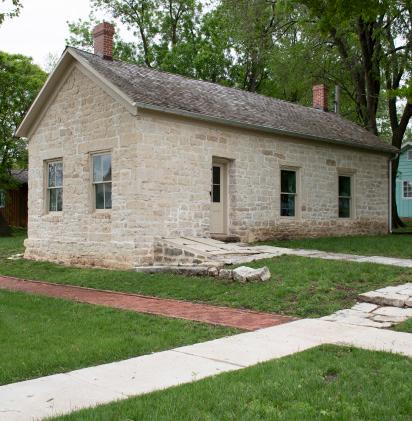
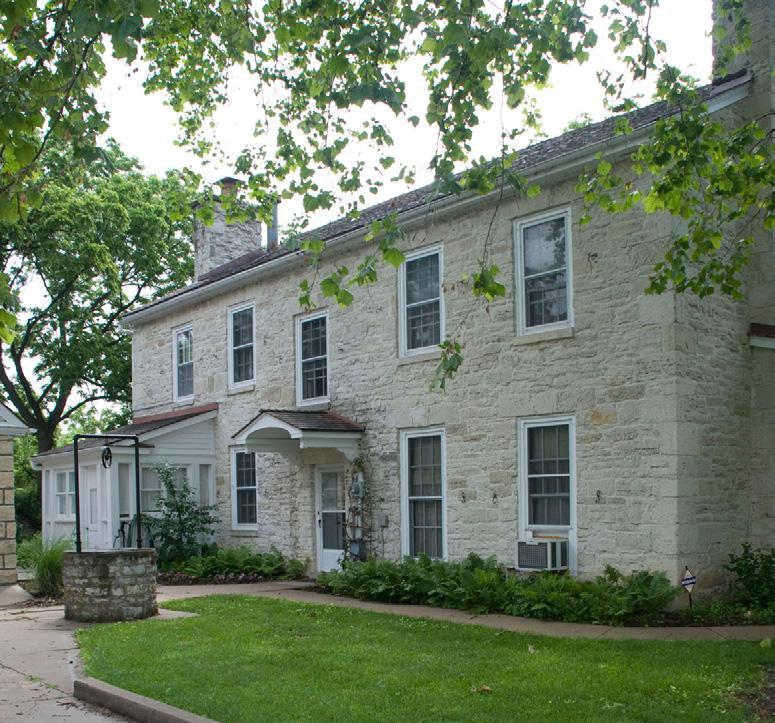


• A glimpse of the new exhibits at Kaw Mission and Last Chance Store State Historic Site in Council Grove

US!
@kansas_history @kansashistorical
this QR code for easy access to all of our social media and more!
Historical Society 6425 SW 6th Avenue
KS 66615-1099
-Next Issue- CONNECT WITH
@kansashistorical @kansashistory
Scan
Kansas
Topeka,
Kaw Mission State Historic Site
Last Chance Store






















































































